#therefore a big part of my editing process is just cutting up said scenes because they don't really make sense in the Chapter as a whole.
Explore tagged Tumblr posts
Text
I recently deleted one little scene, the scene itself was not that important but it featured our lovely Peter singing There Is a Light That Never Goes Out by The Smiths to Elliot while they were having breakfast together and I think that's peak Peter behavior.
#oc peter bane#peter was in a good mood and that's why he beat elliot up and threw him in the trunk later on lol#whump writing#whump community#If you must know#I love a good set-up scene#a good 1-2k word chunk of a mess (as mentioned I'm a yapper#and it's all just my characters interacting with each other#therefore a big part of my editing process is just cutting up said scenes because they don't really make sense in the Chapter as a whole.
3 notes
·
View notes
Text
These are my... 2...? Maybe 50, cents about the whole "freejk" thing. I'm gonna be extremely petty and at some points a whole lot sarcastic and it's gonna be long but I had to say it. As soon as I get my computer I'm gonna make it under read more, but the app does whatever it wants, as we know.
Listen, this ain't my first fan rodeo, and not even the first fan rodeo where I've been directly or indirectly accused of being some sort of pervert or delulu. I've been in fandom spaces since I was a teen, I was shipping mlm couples when queerbaiting in TV shows was still something that was seen as the norm rather than some cheap disgusting trick. I was there when fanfic spaces saw "slash" fics as something "different" and to be tagged with a more mature rating even when they just looked at each other.
I was in BBC's Sherlock's fandom and I shipped Johnlock during the hiatus between S3 and S4, at this point I'm not even feeling it when people call me delulu or a weirdo.
So, yeah, take this with a grain of salt: as a person who has seen thousands of times fandom drama unfolding and has lived too much of it... This whole situation is so ridiculous it makes me laugh. Like, yeah, it's maddening how people will blame anyone and everyone because they don't even see their own bias and homophobia, granted, but like... It also makes me laugh for the sheer dumbassery of the reasoning behind it all?
Like... Y'all are getting mad and for what? Because it sure as hell isn't the invasion of privacy, since y'all are watching the same content we're all watching and you're paying to see it the same way everyone else is. If you don't want to "invade their privacy", you should just... Stop watching content that isn't their music videos, RUN episodes or interviews. Memories and any kind of dvd/video that shows what they're doing behind the scenes shouldn't be part of their job as musicians, and therefore we're intruding in their privacy... Or aren't we?
Or maybe it's more nuanced than that: maybe the content they release on dvd/on their official channels is part of their job as entertainers, and it's been approved, and it's a small window THEY are granting us.
You know what's the REAL invasion of privacy and what REALLY invalidates someone autonomy? When you, who maybe aren't even paying to see that content (which is something I understand, like, dude, I'm not covered in money either), DEMAND what kind of behind the scenes content you want when I swear ABSOLUTELY NO ONE has asked you. Once again: you don't like it? You think it's some huge invasion of privacy? Don't buy it. Don't interact with it. Convince your friends to do the same. For all I care, just go and petition to boycott this kind of content. I know you won't do it, because... That's the thing, isn't it? It's not the invasion of privacy that bothers these people.
Y'all aren't mad because we get into their business or else you would have gotten real mad when we were privy to REAL private moments like people crying their hearts out.
No, no. Y'all are mad because it's "shipping content" and "fanservice" which apparently bothers you because it lacks authenticity.
Pick a side, lovelies: either you DON'T want to invade their privacy, and thus all the content they release should be focused on what fans want to see, or you WANT to know how they interact TRULY in private.
And here's the catch: "shipping content" can be anything. Shipping existed WAAAAAYYY before the word for it was invented, same way with fanfictions. Shipping means, literally, "seeing two (or more) people interact and thinking they would make a good romantic pair". That's it. That's quite literally it. Everything else is just some nuance of the concept of shipping, but at its core, it's nearly impossible to ban all shipping content when it's a group of seven people, because they should for real go in social distancing mode to do so. Most people who have parasocial relationships tend to have "ships" whether they know it or not, because we've all, at least once, looked at a dynamic from the outside and thought "oh man they look cute together". So, even if, o dear ones, your wishes were granted... What the hell do you mean by "shipping" content? Should they just film solo clips, avoiding talking about the other members? But wouldn't that be fanservice, since it's focused on pleasing the fans? (Which, ultimately, is what fanservice MEANS, and I hate to break it to y'all but the whole concept behind entertainment and thus all the content BTS releases it's... For the fans. Like, they're not going out of their way to just meet our expectations but they're certainly doing fanservice by the mere act of releasing bonus content.)
But it's not even quite that, is it? Because no one bats an eye if it's Tae kissing Nj's cheek. I've seen no hashtag against everyone - and I mean literally every one of them - wolf whistling at Nj. It's okay to show intimacy... Because they're bandmates and it's okay to be close to someone who you see basically 24/7, I hear you. And it's also okay when people see that and gush over that closeness, because it's such a nice thing to see.
Soooooo... We've got to free JK from whom exactly? From what?
Are y'all mad cause people pointed out there's very little way a bruise that stayed for a whole ass night could be a quick bite? Because that doesn't harm jk, at most makes fun of him and jimin and their poor excuses (seriously, guys, next time consider using mosquitoes or "I was doing stuff". It'll be equally embarrassing but at least the meme will be funny), and it's literally... A fair observation. Like. It's a hickey, people are gonna make jokes about seeing a hickey and poor excuses of covering it up in the exact same way they're gonna make jokes over jimin falling out of chairs. And yeah, a hickey is AT LEAST something that happens in a sensual context. Like, I could understand "people who are extremely familiar with each other will have different body language/touch in areas where usually you wouldn't see friends touching each other", but that's not. Not a hand on the thigh. It's a hickey on the neck. I don't even know a more stereotypical placing for a hickey. But once again, are y'all mad because someone is pointing it out? Because that's not being delulu or even being a shipper, really, it's just commenting on something that was approved to be shown and discussed in something that was released BY THEM.
Are y'all mad at hybe for showing something that literally fell onto their hands? Cause like, unless someone (I'm counting on Jimin, since as we know Jungkook was busy spinning him round and round and had both his hands busy) called at hybe headquarters to say "yo bang pd substitute, is it okay if I give my friend jk here a hickey? Cause he's being really annoying rn and he has to pay", I highly doubt anyone expected Jungkook to come to rehearsal all neatly marked up. Or idk, maybe someone at hybe asked them "we need Jungkook to come in with a hickey but refuse to say it's a hickey, so that fans will feel reeeeally served." That sounds perfectly plausible too. Or a good marketing strategy.
Now, if you're a big company and your objective is to have some footage of the rehearsals for a concert, and the fandom is too good at noticing stuff for their own good, and one of your artists comes in with a very visible mark, and he and his bff bropal4lyfe come n with a story about how they were playing and a bite happened, you've got three choices: 1. Cut the artist out of aaaaalll the footage. Someone would have noticed the "bite mark" anyway, you best believe that. If you don't want anyone to notice it, you gotta cut him in most of the footage where it's visible. 2. Keep the hickey, discard the explanations. You could do that, but also it would feel a lot more unfaithful to everyone involved. Also they clearly worked their ass off to invent an explanation, come on! They truly tried to do their best inventing something that was not "it's a mosquito bite", they should get some credit! 3. Keep the bite, keep the explanation.
Notice how none of these solutions include the biting never happening because... They couldn't prevent it? The only thing they have any control over is how they're framing each "accident". And that's not an easy job.
I applaud you, people on the editing team.
So... On whom should we cast the blame now? Ah, yes, I think it's finally time for the ultimate scapegoat of this fandom: Jimin. Which is funny, cause... You know... If this were really about privacy, or being "victims" of shipping... This should be about freeing him too, you know? But obviously Jimin does it for attention, while Jungkook, poor angel that he is, doesn't even know what shipping is.
Furthermore, don't we all know how much Jimin imposes himself in Jungkook's life? To the point where he, multimillionaire man feels compelled to share a car with Jimin even if they're both late in the process. And can't you see how uncomfortable he is, draping himself over Jimin, making Jimin drap himself over him?
Oh lordy, truly such an awful eight years Jungkook spent, choosing to have vacations with someone who made him uncomfortable, spending free time with him, even having to suck his ear in public to the point you can see his saliva just because Jimin was sad :( truly an all-around bad time for Jungkook, as evidenced by alllll those times when he said Jimin was pretty, cute, and all-around knowing every little thing about Jimin. I absolutely concur, the dude would be so much more happy if jimin was not in his life.
Did that sound weird and absolutely ridiculous and a really absurd joke? Because that's what y'all sound like to me. Like. Jungkook is out there living his best life, getting hickeys and showered in affection and y'all paint him as a fucking martyr??? I'm sure he's really truly desperate that Jimin holds him in such high regards 😭😭😭 I can see him suffering whenever he starts doing his own serendipity rendition 😭😭 and when he claimed you are me, I am you as his and Jimin's only 😭😭😭 I cannot believe this poor baby 😭😭😭
I've reached a point where every time I hear this stuff I laugh because the levels of twisting reality when it comes to jikook are extraordinary, Jungkook will have a literally blissed out face and people will cry in outrage.
But coming back to my point: let's pretend you're not mad at Jimin and the possibility that jikook are dating: are y'all mad... At the hickey? Because at this point it seems like the only feasible solution. And if you are, do not worry: I'm sure Jungkook's skin was throughly healed by his boo. A kiss soothes even the worst pain, doesn't it?
61 notes
·
View notes
Text
Whoopsie King Rhoam’s a dick but I gotta flesh him out so
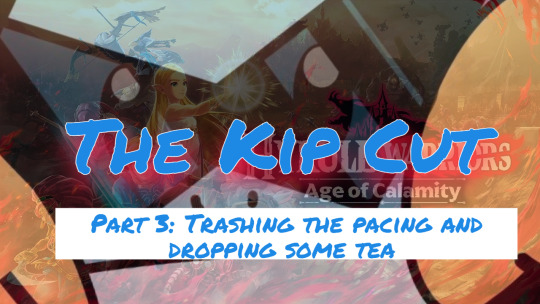
Read Part 1 here!
Part 2
If you’re on mobile, and tumblr hates this post, follow along on this google doc!
Rules/overview this rewrite in the beginning of Part 1
‘sup ya beautiful bastards it’s time to gush about the process of storytelling and writing as we fix up the fix it fic so let’s just jump into it
- - - - - - - - - -
A quick recap of Part 2, and I swear this recap is faster than the recap last time: Chapter 3 of Age of Calamity opens with a more substantial scene the beginning points of Revali’s character, and contrasting the old position that Link and eggbot have, so that their later changes in this chapter (well, at least for Link in this chapter) are more pronounced. We edited a bit of the dialogue to make Revali’s intentions make a bit more sense, while also putting some little foreshadowing points with some camera tricks for the Hollow Champions. The Hollow Champions can now speak, which means their potential for being used to bring out the flaws or bitter aspects of each character is more readily available further into the story. And of course, we’ve introduced the main antagonist of Astor, and coupling his presence and dynamic with Zelda’s insecurities. While his intentions of needing Zelda for something is clear, his motivations and backstory remain a mystery as of yet, the only true clue we have so far being some sort of connection to eggbot.
I didn’t get any big asks or comments about Part 2 so I’m going to assume that it was mostly well received (although I will note that I promise I’m going to flesh out Revali to be more than he has been presented as of yet, this is just the very very start of this development don’t you worry your feather loving butts) that being said, you should totally critique me or give me your opinions or comments. I’d love to hear them! Although, keep in mind that I am restraining my rewrite to the guidelines already said, so don’t get mad at me for not killing off all the Champions or something. Thaaat’s a rewrite for another time. So yeah if you reblog you get a little kiss from me because believe it or not I spent a lot of time trying to rewrite an entire storyline while keeping it’s tone and integrity intact. So thanks much <3
Okie dokie then chaps! Let us finally delve into Urbosa lesbian vibes, a zest of Zelink angst, rants about pacing, and a couple tablespoons of Astor backstory, all starting in the latest stage of Chapter 3: The Road Home, Besieged
So right of the bat, big problem here. This Chapter follows directly after the events of Korok Forest, so you assume that maybe “The Road Home” refers to the team, going home, back to the castle, to tell King Rhoam what’s up. But...that’s apparently not the case.
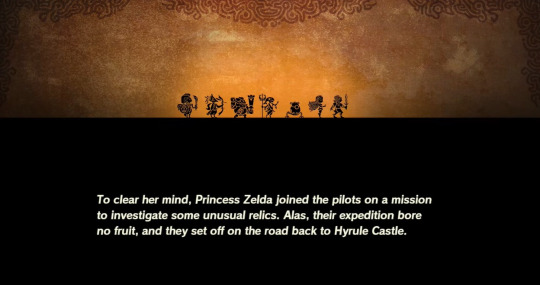
So this entire stage, firstly, it brushes over any scenes where Zelda, Link or the other Champions might talk to King Rhoam about the Master Sword, or the Deku Tree, or...hmm what else happened last stage that might be interesting to see—oh yEAH HOW ABOUT that mysterious magic guy that tried to kill Zelda and was going off about the future and stuff?? That guy that wielded a bunch of dark magic and malice looking stuff and, uh yeah, you’d think it might be important and interesting to see the King’s take on was is essentially a wanted traitor to the crown who may or may not be leading the entire movement for the Calamity’s uprising. But nope, no one asks questions, no one says anything or has interesting conversations that reveal stuff about the plot. It's just….just all about Zelda and ooooOOooo she can’t awaken her powers oh no what’s a gal to do!
And I do mean that quite literally, this entire stage is all centered around two scenes with Zelda. The first, an admittedly narratively important scene of Zelda having a quick flashback about eggbot after he sings her a song, but it lasts for five seconds. And the second, being a pep talk with Urbosa as Link eats rocks in the background. For the majority of this stage, it’s all focused on Zelda, and pacing wise, it does virtually nothing to progress the narrative/plot forward.
And on paper, there’s nothing wrong with that! Hell, people read entire fanfictions dedicated to character development and relationships that have absolutely no external plot. Having a scene dedicated to just character development is completely fine, it’s something that’s pretty common and even encouraged to an extent. The problem arises when you remember that this is a story being told through the medium of a video game.
Now, I am going to try and breeze by this because, similar to Age of Calamity, I have to also construct this post with pacing that keeps my audience engaged, while progressing with my core narrative and story. But I highly encourage you to watch through this video by hello future me (On Writing: How to Master Pacing) because a lot of what I know about this I’ve picked up from his videos, and if you’re a writer or just someone who thinks storytelling is cool, it’s a great guide to the art of pacing.
youtube
Anyhow. There are two levels of pacing within a story. There is the small type of pacing, like for the structure of a singular scene. And there is the pacing of the overall core narrative, how the larger beats of the entire story is revealed. Good pacing for your core narrative is about whether the reader feels like they are getting closer to the big thing, the big climax or answer or promise of satisfaction. The smaller type of pacing, for your singular scenes, focuses on that timing between how close you get to achieving new information, this refers to your slow and fast pacing, tension versus rapid action.
So, overall the rule of thumb is: the amount of time you invest into your smaller scenes, even put together, that must correlate with a big enough payoff in the core narrative. That’s what good pacing is. (And that’s why people make stuff like the Three Act Structure to help visualize this pacing process but obviously other forms of pacing guidelines exist like the Five and Seven Act Structures but that’s too complicated for this Nintendo Game anyhow that’s just some educational flavour for ya to impress your highschool English Teacher I guess)
So knowing that, the question now is: Does The Road Home, Besieged contribute good pacing to the story? This is going to be my excuse for changing up other later scenes in the game, so when I mention pacing and narrative again, remember this. The time spent playing for thirty minutes, minimum, in the game, to only be paid off by two lines of character development isn’t good pacing. So the answer is “no.”
Delving as long an amount of time as thirty minutes, means that pretty much everytime a stage is complete, you must introduce new substantial progress to your story. A game like this just doesn’t have time to waste it’s valuable cutscenes on character development alone. There’s an even further wrench in the issue when you consider you also need to account for sidequests, so you could really be forcing your player to go through hours of gametime before you introduce new details in the story.
Obviously it’s not always gonna be cut and dry like that—sometimes you have to account for how enjoyable the gameplay is, and sometimes the amount of character development offsets any lack of narrative development—but for the majority of stages I’m gonna change, they all suffer this pacing problem. In a game that's entire story hinges on these cutscenes, bad pacing is just something it doesn’t have time for.
Anyhow anyhow anyhow, I got to get my dose of serotonin by talking about pacing writing structure and stuff and blah blah, so now I shall grace you with the changes that address these problems that would theoretically lead to vast improvement. I gave you this reasoning and backstory to writing because I am making hella changes, to hopefully make the experience more “poggers,” which is something the cool kids say these days if you didn’t know.
Firstly, timeline wise this stage is gonna take place directly after the Korok Forest battle. The gang is returning home from the battle, with Link, the new wielder of the Master Sword, along with this new information regarding a certain Astor character.
We open the same way it does in game, focusing on Zelda’s face, before the frame is suddenly blocked by the pommel of the Master Sword. A wordless way to express how the sudden revelation of Link being the hero has forced its way into Zelda’s mind, great use of camera Koei Tecmo 10 outta 10

Now I don’t want to immediately jump into Zelda’s “oh poor me I can’t awaken my powers” dialogue because—and this is something even Breath of the Wild is guilty of—This game seems to forget that there are other characters besides Zelda. It’s marketed towards kids, sure, but I assure you that kids playing this game have a longer attention span than 2 minutes. You don’t need to keep reminding the audience every single scene about how Zelda is anxious about her powers. It gets redundant, you waste the audience’s time, and therefore you waste your own time, because you could have been using that precious screen time to develop some other thing further. So anyhow, goes a bit like this.
Zelda’s walking, the Master Sword comes into frame. Zelda looks down at the ground but keeps walking, but you can tell from her expression that she’s troubled. Don’t need to waste time on dialogue for her here, show don’t tell, we need to make the most of the scene here. Camera is still on Zelda, but the focus blurs shifts from Zelda to the Champions behind her. We can start with Mipha, I don’t have my heart set heavily on any specific dialogue, but I want her to say something along the lines of “how proud she is of Link” and what an honor it will be to fight by the side of not just her dear friend, but also someone selected by the goddess to be the hero. Subtextually, I want her to say this in a tone that suggests that she doubts the need for her to be here at all. She’ll say something like “He’s grown so…” glances up at Link who's just walking ahead, “...so much stronger than I could ever imagine. [Something Something] His power has grown so much over the course of a few days, more than I have achieved in a lifetime.” She looks down, but she still has a sweet smile.
Now I’m doing this because I want to develop further this plot line of “getting stronger” that Age of Calamity sets up but never does anything with. Remember how in Chapter 2, Mipha asks Daruk to train with her to get stronger? I really like the possibilities of this arc with Mipha as it can not only parallel with her feelings for Link, but also make her character better as an individual. Mipha wants to get stronger so that she can protect Link, but now she thinks that Link’s already growing stronger to an extent that she might not be needed. She’s not jealous of Link, nor does she wish him to be weaker, she simply wants to be more than she already is. This is literally echoing her words that she left her father, about how leaving the Domain and experiencing new challenges would be “good for her.” So I wanna run with it. The dialogue here establishes Mipha’s motivation to grow stronger, almost equivalent to a rivalry of sorts.
So after Mipha says this, Revali scoffs and butts in. Again, I’m not too set on any particular dialogue here, just something like “Hmph! Well, I don’t know about that. Seems to me all that’s happened is some magic sword gave the knight an ego boost. Blade’s only as strong as the little Hylian who wields it, and—based on my own extended experience and professional observations of course—I’ve yet to see this ‘stronger’ boy that you speak of.” Another camera pan to Link a ways in front of them. “If you ask me, hero or no, that knight is still exactly the same as I first met him.”
Revali places a wing on his chest dramatically. “Perhaps if you’re truly keen on seeing growth in skill and strength, Mipha, you’d do well to—”
“Flattering of an offer as that may be, Revali,” Urbosa interjects, “But I think Mipha might find it difficult to observe growth from one of the shortest Rito in Hyrule.”
Cue laughter from others or snickering or something. We just need some banter to add a bit more flavour to the characters. Revali can do a little huff and cross his wings or flip his scarf or something. But then Urbosa continues.
“Although...he is right about one thing.” Urbosa looks straight ahead. “A sword does not alter a hand, just as strength does not alter character.” She puts a hand on Mipha’s shoulder. “Grow as he might, there is no doubt in my mind that he is the same boy as he’s always been.” Urbosa looks up in the direction of Zelda. “Whether you realize it or not.”
Ok so, scene’s not done yet, BUT quick gush on the dialogue flow here. I’m trying to establish parallels in these character perspectives based on the flow of conversation. We started with Mipha who, like I said, wished to grow stronger along with Link. This flows into Revali who also has a similar parallel as he wishes to grow above Link’s shadow. But the distinction between Mipha and Revali is that Mipha think’s Link’s strength is earned, and Revali thinks he cheated, gaining authority through a magic sword, and not through merit and skill. Thus, leading to Revali’s perspective of Link being exactly the same as he’s always been, he believes the sword doesn’t change anything. Urbosa then speaks, because she thinks exactly the same thing. However, her distinction is that Link is the same as he’s always been: a determined young boy earned his place and cares for his friends. Then she looks to Zelda who, as we know, will develop a perspective that contradicts this. So you get it? This scene is like 20 seconds long but it already mirrors nearly all the character parallels and perspective, that’s why the flow of dialogue is important. And I know half of you probably think these kinds of details are a stretch but I promise you it’s not, just look at any movie or show ever and I guarantee you can find similar stuff there too. Ok moving on moving on—
Urbosa looks up at Zelda, comments her, “He’s the same boy, whether you realize it or not” piece of dialogue. Camera shifts back to Zelda and Link, who, idk if I mentioned this, but in the scene there’s enough distance between the Champions and Zelda and Link that the Champions can speak without the other two listening. So they didn’t hear any of this.
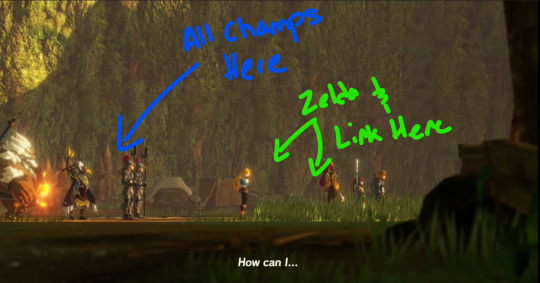
So the camera is back on Zelda, and now we can get her “How can I…..If I am unable to awaken my inner power….” line. Eggbot senses her sadness, does his little cheer up dance, Zelda gets a flashback.
One small change I wanna make to this flashback: Instead of just a baby Zelda going “nighty-night” I want there to ALSO be a figure in the background behind eggbot wearing a silk royal blue dress. And said woman has blonde hair and she’s by the table back there. We don’t have to show her face or anything because Nintendo hates that. Just place the woman somewhere in the back somewhere

Also possibly you could add the shadow of another figure by the doorway, maybe? It would serve good continuity purposes for the plot points that I’m telling, but that part is not as necessary. I just need at least the woman there.
Then Zelda is like “I remember you” to eggbot and all that and blah blah… Now, instead of Impa offscreen just yelling “enemy ahead!” I just want it to be a full on ambush. Not like a major one, but just enough where the group is surprised a bit. Maybe on the cliffs above, a lizalfo throws a boomerang, or a bokoblin shoots and arrow, or even just throws a rock. I don’t really care. I just need this to happen because…
As soon as this danger is presented, Link turns around to grab Zelda’s hand and they start running again. And he can like use his body to try and shield her a bit, I need it to parallel how he acted during Chapter 1 on the road to the Royal Tech Lab. However, this parallel has one important distinction because…
Zelda rips he grip from Link’s after a moment. “You don’t need to coddle me!” She says, or something along those lines. “Y-You...You’re the hero aren’t you! I’m perfectly fine, you don’t need to spend your precious time playing babysitter to me.” In the distance, a horde of monsters is beginning to form. Zelda looks between the monsters and Link’s Master Sword, her expression unreadable. “Well? Just...just go do what you need to do.” Link hesitates, looking between her, and the approaching monsters. Zelda speaks more sternly now, “Go!” So Link, not one to disregard an order from the Princess, gives one last look to Zelda before setting off towards the monsters. Maybe Zelda can take a deep breath to steady herself after he leaves, but as soon as Link unsheathes his sword, the metal glistening in the setting sunlight, it cuts immediately to gameplay. Start battle.
For essays’ purposes this is the part where I explain why this is better than the original. So here’s my reasoning:
Uhhh, it just is. :3
Ok but seriously, I’ve already talked a tone about why the pacing and dialogue flow is better than the original. But also this scene doesn’t just say “Ooo Zelda is sad about her powers,” because that’s not interesting. Like I said, it’s redundant information. What is interesting is see how characters deal with that internal conflict and how it affects their relationships. AKA Zelda’s relationship with Link, who now basically embodies the success that she’s been working so hard towards but never achieved, is deteriorating a bit. I wanted to get that sense of the Zelda that we see in Breath of the Wild because all things considered, they should be roughly the same character.
So that’s that, you fight the battle, the Hollows show up a bit, so insert “dark evil Champion” dialogue because if you’re gonna use the evil clone trope might as well use it to the fullest. Then you fight the Talus and hurray horrah the day is saved.
Then we have that iconic Urbosa motherly pep talk to Zelda as Link eats rocks in the background. Now honestly, I’m not that big a fan of the first half of the dialogue, so I wanna change it into something more interesting. But the rest of the beats and camera work go roughly the same.
Zelda: “Link is...so much stronger now”
Urbosa: “‘And yet I have not.’ I presume that’s what you’re thinking, hmm?”
Zelda: “Well it’s true, isn’t it? More and more, monsters have been appearing around Hyrule. It is a sign that the Calamity draws near. So...there isn’t much time. And still, no sign of my power awakening.”
Urbosa: *sighs* “Little bird…”
Zelda cuts her off, in an attempt to change topics: “Why do you call me that?”
Urbosa: “Hmm?”
Zelda: “Little bird...I feel like I’ve heard it before. Why do you call me that?”
Urbosa, after a beat looks off in the distance or something: “A long time ago, my dear friend would call me to the palace, or perhaps invite herself over to mine, [she chuckles] ...and she would talk with me all day, and ask me to gaze upon her little bird with her. Her dearest daughter...a princess”
Zelda: “You mean my…”
Urbosa just smiles with a soft nod: “Back then, times were a bit different. The destiny that you have was still upon the Queen, who worked day and night to refine her powers and fulfill her destiny. In just a few short years, I went from being friends with a Queen, to friends with the destined sealer of the Calamity.”
Another pause, before Urbosa speaks again: “But...she was still the same woman I had grown with. Still the same loving mother who spoke about her little bird with joy. She had not changed one bit.”
Urbosa: “Even when your mother passed, her loving smile was there until the very end. She always loved you—believed in you, Zelda. She had great hope, great faith that her daughter would grow into the beacon of light Hyrule needed. That even with her gone, you would spread your wings and fly, because you were just that amazing to her.” *Urbosa puts her hands on Zelda’s shoulders.*
Urbosa: “Destiny did not change your mother’s love, just as it does not change Link’s courage, or your value.” *the camera can pan to Link eating rocks now*
Urbosa looks directly at Zelda now: “Look how hard we’ve all worked to get this far, how hard you have worked to get here. While we may grow in strength, in that regard, we’re all one in the same.”
Zelda: “...I….well…”
Urbosa: “What did the Great Deku Tree say? There is no need to fret princess.”
Urbosa: “Our faith, Link’s, your mother’s, it’s all as strong as ever. And everyday, with every moment that you travel towards your destiny, it just grows. It is always with us. So believe in that, have hope, yet, little bird.” *Eggbot can scurry up and make cute noises here next to Zelda*
Urbosa: “I know, you are where you need to be. You must accept that too.”
Zelda: “...”
Zelda gives a solemn nod: “Thank you, Urbosa.”
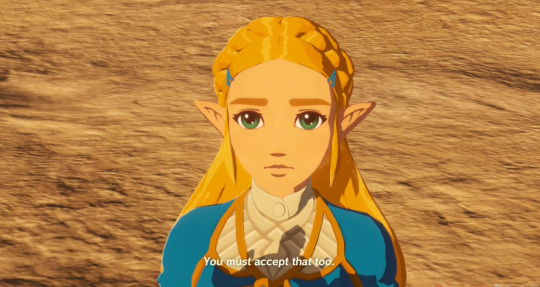
So that’s that scene! Don’t let the length fool you, it’s technically even shorter than the original scene in Age of Calamity. So why is it, in my opinion, better? Because for one, we actually get an insight into Zelda’s mom and Urbosa’s relationship, something that was PROMISED To us but never given and I’m still a bit salty about it. Anyhow, in addition to just getting some lore details, that relationship between the Queen and Urbosa is important for this scene because, just like Urbosa spells out, it’s in direct parallel with Link and Zelda.
Before the Queen suddenly got sick and died, she was destined to seal the Calamity. But she didn’t let that destiny change her, she was still the same loving mother to the end. Now that is something that Zelda needs to realize about Link, as his newly acquired destiny doesn’t change who he was before, the knight who cares for her and wishes to protect her. Zelda needs to realize he’s the same and that she can still trust and confide in him. Hence, that’s why this mom backstory is in this scene and not somewhere else, because it serves to the narrative but also more impactfully to the character development.
The dialogue could probably be polished a bit more but come on, not half bad for an improvement yeah? So that concludes Chapter—
SIKE we’re not done yet. We still have to move into the entire point of this stage, the road home, to the castle.
So, badabing badaboom, I’m adding an entirely new scene from scratch right here at the end, because it is VITAL that I set up something new about the story, as a sort of clincher. So anyhow
Zelda is alone with her father, let’s set it in the royal library (Intact, not ruined, of course) because we don’t see enough of that location and it’s really cool. So Zelda is briefing her dad about the events in Korok Forest and on the journey back home. I know I always gush about cinematography but it can’t be fully appreciated since I’m….writing,,, this, BUT I think it might be fun if the side shots of Zelda have her background be some bookcases of the library, maybe half bookcases and the other half the ornate walls. Then the background for the King’s shots is the full symmetry of the elegant staircases.
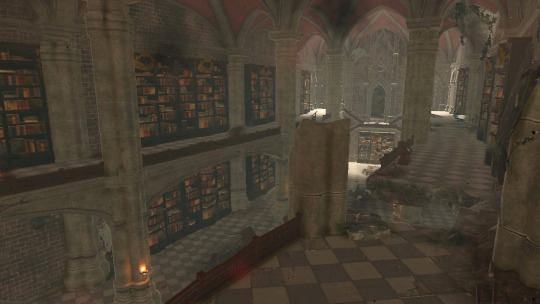
[And if you needed the specific reasoning for that, because it makes camera shots more fun. Like when Zelda says something that aids in her scholarly side, the camera angle can change slightly where the bookcases take up more of the frame, and then when the King’s will takes more power, then the book cases can be angled a bit more out of frame. And then the symmetry of the King by the staircase is a way to show his higher power dynamic to her, and contrasts well with Zelda’s shots since the bookcases are dark and the stone is lighter, so on a meta level is also makes it easier for the audience to understand where they are. Shot composition is fun ok, and that’s not even getting into color theory (Thinks about Baby Driver and LaLaLand....even videogames like Undertale and Hollow Knight have such wonderful shot composition and use of color theory hhhhh love it)]
Ok so Zelda’s briefing the King in the library, she’s standing while he’s sitting at a desk. There’s maybe two or four Royal Guards on the staircase entrances, but for the most part, they’re alone. You can tell that this meeting between them has been going on for a bit now, as from Zelda’s dialogue, she’s retelling events midway through the story.
The King is flipping through some paperwork, not really looking Zelda in the eyes. She continues speaking.
“And so...with the malice cleared and the monsters being dealt with, Link and I made our way into the heart of Korok Forest.”
The King hums a response, flipping through another page. “And this is when Link pulled out the Sword that Seals the Darkness then, I presume.”
Zelda paused, as of thinking of how to phrase her next words. “Not exactly. I...we both encountered someone beforehand. A man, with a pale face, and dark hair and robes, and he had the power to control malice, using a strange object in one of his hands.”
Rhoam stops writing in his journal or whatever. He doesn’t look up, but the sudden stop he makes is obvious. Zelda notices, but continues.
“He talked about...the Calamity, and my birthday...destiny, and the future….I’m not quite sure I can remember his intentions word for word. But he did introduce himself as—“
“Astor…” Zelda and the King say simultaneously. The King has fully perked up now, looking at Zelda. She’s pleased to see a reaction from him. The King rises from his chair, and starts pacing a bit, stroking his beard thoughtfully like the asshole he is.
“So you know him then? This Astor man? Who is he, father? What does he—“
“Were you alright? Did he hurt you, or mention anything else?”
Zelda pauses for a moment before shaking her head, as if the concern he was expressing was uncharacteristic. “N-No. No, I’m fine, and Link was there. During the battle, as Link fought him off, that was when the sword was pulled. Then Astor fled, or...” Zelda pauses for a beat, “retreated...he expressed his wish to speak with me again.”
Another beat of silence, as Rhoam gets up, hands clasped behind his back. “He used to work at this very palace.” The shot is now directly on Rhoams back, as he faces a bookcase, although it’s clear that he’s just deep in thought, and not just staring at books. Rhoam is in third column of the shot (he’s to the right, not in the center)
“A trusted advisor. Someone gifted with foresight, who many years ago, had first predicted the coming Calamity.” Cut to shot of Rhoams face, the camera being by the bookcase, so that we see Rhoam’s expression and Zelda’s.
“In truth, I thought him dead. For the last time I saw him alive—truly, truly alive—was ten long years ago...” The shot goes back to the original establishing shot, of Rhoam facing away from the camera, towards the bookcase, he’s standing to the right, hands still clasped behind his back.
“...when your mother still graced this earth.”
From left frame, a younger Astor walks up and stands beside Rhoam. He runs his fingers along the books. Rhoam looks to his left, as if he is seeing Astor. Camera cuts to Astor’s right, as if looking at him from Rhoam’s perspective. He continues brushing his fingers against the spines of the books, before he finds the one he’s looking for. Pulling it out, he opens the book, flipping through its pages, before giving a genuine smile. Cut back to wide angle behind them. With the book, Astor starts walking back out left frame, but this time the camera follows him. Filter fade to a memory tint as the camera pans right to left
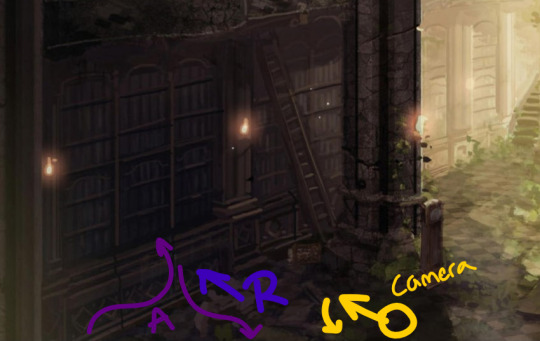
[when the camera fades fully into the Astor memory, the figures can have that silhouetted effect like you see in botw. Cause I know Nintendo hates making new character models for some reason.]

So if it wasn’t clear already, even though the memory filter doesn’t come immediately, Astor isn’t actually there, but it’s just a flashback. I’m a sucker for merges, which is something this game and botw NEVER do which bugs me because there are so many creative ways you could introduce flashbacks without just doing “ooOooOoo fade to sepia filter and then oooOOooOOO we fade back to reality and no time has passed.” I apologize if my explanation of the camera doesn’t make sense as it’s hard without much visual aid, but hopefully it makes sense so far. Anyhow! Let’s continue.
We’re now fully immersed in this memory, but King Rhoam’s voice still narrates overhead.
Astor brings the book to one of the desks in the library, where a woman sits writing something onto paper. News flash, it’s the queen. Astor hands her the book and starts speaking about something, although you can tell the tone of their conversation is light, almost akin to Zelda rambling about Sheikah Technology. The Queen laughs about something unheard, as Astor continues ranting about something, his hands moving to like a professor giving a lecture.
Rhoam Narration: “When he had first predicted the Calamity, things were much more hopefully for our kingdom. As although his foresight granted him only glimpses and fragments of a future, he was almost certain that with the Guardians, and the strength of your mother’s power, our victory would be absolute.”
Scene changes to the Queen walking down a corridor, Astor is leaning against the wall by a window.
Rhoam Narration: “He and your mother would often work together tirelessly to study the ancient arts, to make the most of the powers given by the goddess.”
The Queen has walked up to Astor now. She crouches down and gestures to her left, the side not yet seen by the camera.
Rhoam Narration: “In fact…”
The camera changes to focus to where the Queen was looking towards—a young Zelda, crouched behind her mother’s dress, stares up at Astor.
Rhoam Narration: “I would not be surprised if you found within yourself, a memory of such.”
I would prefer if you could see the expressions of Astor (giving Zelda not a smile, but not really a frown or anything rude either) and young Zelda. But I guess it can also just be silhouettes too cause again, Nintendo hates giving us younger character models outside of first person POV stuff. Anyhow.
The scene fades, the light from the window dimming as everything darkens.
Rhoam Narration: “I often times wish we could go back to such a time, when victory and pride swam in every corner of this castle. But of course…”
The scene brightens again, although not as bright as before. It’s the exact same corridor with the large window, but now it’s raining. A young Zelda stands alone in front of it, looking outside.
Rhoam Narration: “Such a time did end…”
We now cut to a new scene, King Rhoam is walking down a hall, the camera’s perspective is of a bird’s eye view, like we’re peering in from outside a window. We can see the shadow of Astor chasing after him, as he starts speaking frantically about something, not quite, but almost to the point of shouts.
Rhoam Narration: “After your mother died, the visions of the future shifted drastically. No longer was there glimpses of rolling fields and shimmering skies, but instead, of rubble, red earth, and death.”
You can now more clearly hear the words coming out of Astor’s mouth. He is telling something about failure, and souls, and the Calamity to the King’s ear. He’s still walking forward.
Rhoam Narration: “He was adamant that our demise was now coming faster than ever, and that without your mother, we were doomed. That even you, should you take up your mother’s mantle, could not save everyone.”
Astor: “I’m telling you Your Majesty, if you go down this path, there is no going back.”
King Rhoam: “There is no other choice, we are moving forward.”
Astor: “I don’t think you quite understand the true gravity of the fate you’re choosing for yourself. It is a guarantee that you, me, and countless others shall die.”
King Rhoam: “I don’t want to hear it.”
Astor: “And of course, there are a multitude of possibilities, but the end result is the same.”
Astor: “Do you have a preference, perhaps? Crushed by rubble? Suffocation under ash?”
Rhoam’s tone is deadly: “Stop.”
Astor: “I’ve seen fire too. I’m not yet quite sure the exact circumstances that lead to flame appearing and spreading so quickly, but rest assured that if you—”
King Rhoam: “Stop.”
Astor: “If you saddle someone else with this duty I am absolutely certain that you and I will—”
King Rhoam, voice not shouting, but still with a booming intensity: “Just like you were so certain of our victory 10 years ago?”
Astor’s face darkens. He’s silent for a moment, collecting his words before practically spitting the first articulation: “...That, future, was the one that would come to be if Her Majesty was alive. If you’re so unsatisfied with my departed wisdom you can go ahead and flail around with destiny alone. You think I choose for these events to happen? You think I lie when I saw I want what’s best for this kingdom—”
King Rhoam: “What’s best for you.”
An ugly pause.
King Rhoam: “It is decided, Seer. It’s time you accept this. My wife is dead. That is the truth. Thus the role of sealing the Calamity shall pass to my daughter. She will work to awaken her own ability. It will be her duty to save us.”
Astor half laughs: “A child?! Surely you don’t need the supernatural to see how foolish that is.”
King Rhoam’s voice is even more stern: “You are living proof that the future is not absolute. Therefore I...must place all belief in her ability.”
The King walks away, leaving Astor alone. Weirdly, he smiles. Perhaps to mask some other emotion.
After another moment, Astor yells to the King: “I’ll fix this! Alone if I must!” He’s chuckling as he shakes his head. “Your useless faith may cost many lives, but even so mark my words, I will fix this.”
The King looks back, but says nothing, his expression unreadable. He continues forward, leaving Astor alone chuckling, or perhaps something in between chuckling and crying to himself.
Rhoam Narration: “We haven’t spoken since that day. I simply left him to his devices. If he was so determined to find another way to stop the Calamity, then who was I to stop him. I doubt my word could have swayed his mind regardless.
We’re now looking at a room, the camera is just by the doorway, looking at an office, circular and domed. It’s stone brick walls are covered in parchment and ripped books, covered in symbols and frantic writing. An old Sheikah tapestry hangs crudely on the left wall, and the window on the right seems to tint grey, or even a deepest crimson. Centerframe, is the back of Astor, robe hanging just above the paper ridden floor. He is flipping through something on his desk.
Rhoam Narration: “Fixated as he was on the perfect future that you mother might have led, I still had hope that with time, he might still assist you with your destiny one day.”
The camera slowly comes closer to Astor. We can see more clearly the type of stuff that sprawls the papers and books and diagrams across his office. Some depict stars and constellations, and even a few notes on Ancient Technology, although in a noticeably cleaner font. However, as the camera moves close and closer to Astor, the papers and books depict only one clear topic: the aura of death that comes only with necromancy.
Rhoam Narration: “It seems…”
Astor finally reacts to whatever he was doing on his desk. You don’t see his eyes, but as he fully turns around to face the camera, you see his smile, along with him holding a dark orb of unknown energy. It hovers in his hand.
Rhoam Narration: “...I was mistaken.”
The camera cuts to a wide angle, looking at Astor from behind a stack of books on his desk. The stack of books on Astor’s desk brighten in color (from the memory dull filter), until the scene fully fades back into the Royal Library. The camera is now focused on a similar stack of books on the desk behind Zelda, where Rhoam was working before.
Zelda is still looking at her father, who is still turned away. Now, he turns back around to face her.
“He had disappeared completely one day, so it was my understanding that whatever he was working on killed him. However, if he is truly back as you say…”
Rhoam walks closer to Zelda, close enough that he might have put a hand on her shoulder, but his arms stay behind his back.
“It is in your utmost interest to prove him wrong. I know not what he plans on doing, but it would be wise to stop him before he does.”
Rhoam turns away now, pacing back to the otherside of the desk. “But, your more important priority is unlocking your powers, understand? Now more than ever, is not the time to get distracted.”
Zelda, taking this all in, takes a deep breath. She then nods at him. “I understand...Father.”
After a moment, the King makes a motion as if to dismiss her. She starts to walk away, her thoughts churning in her head, heart thumping to the same beat as her echoing footsteps. Suddenly, Rhoam calls,
“Zelda.” It’s not a question, but the tone is asked like one.
She turns back, looking at him, expectantly. Rhoam only stares at her, an uncharacteristic moment of uncertainty for him. The words he wants to form seem stuck in his throat, until finally, he lets out a quiet breathe through his nose, before simply saying:
“You must.”
Zelda can only frown, her shoulder’s slumping slightly, as she ducks her head and leaves.
- - - - - -
And that’s that! That’s the complete end of Chapter 3. So tune in next time for Chapter 4, including a new slight but important story changes, Yiga husbands, and shocking turns of events.
Edit: I forgot that posts with link’s dont show up in tag results so a rb is appreciated :p
#Hwaoc: The Kip Cut#fuck this is the biggest one yet#hwaoc#age of calamity#hwaoc rewrite#hw age of calamity#hyrule warriors age of calamity
42 notes
·
View notes
Text
story process challenge
i was tagged by @xldkx to do this challenge, created by @herpixels , like a month? a month and a half? ago and it’s been sitting half finished in my drafts for nearly as long. *sigh* (regardless, i love stuff like this so even if it takes me forever to get to it, i appreciate the tags! 💕).
i decided to answer all the qs because it took me damn long enough to get to this, so i might as well put some extra elbow grease into it (plus it was fun!). btw it’s all going under a cut b/c it is long. i apologize in advance.
1. My Writing Process - used to be a hot damn mess. literally word docs strewn throughout my pc. However, I recently switched to using Onenote (it’s what i use to organize my d&d campaign notes) and hoo-boy is it so much nicer. this is how it’s set up and it’s honestly night and day. i can have a page with outlines, a page to organize & order screenshots, and a separate page for drafting text, and i can easily toggle though them without having to switch windows? a big thumbs up from me.
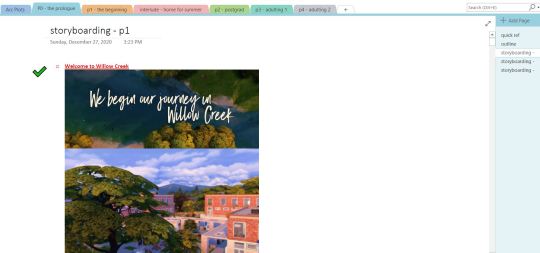
When it comes to actual writing- I used to write my drafts in novel format, which i enjoyed but it made “converting” them into tumblr posts time consuming and frustrating. I ended up scrapping most of the text in the process, retaining pretty much only the dialogue.
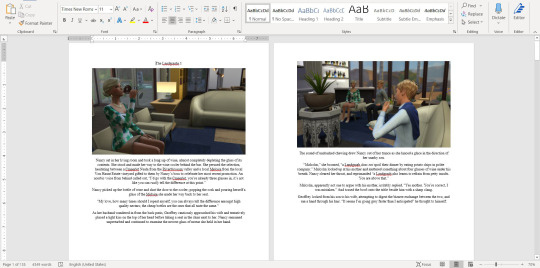
Anyway, nowadays I write in more of a screenplay format: dialogue only + key scene information with the occasional note to self.
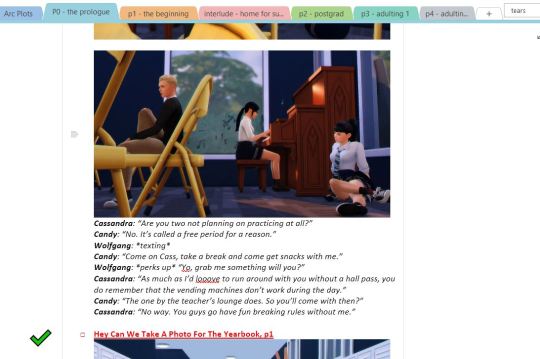
I do keep a master “arcs” page with key events and each individual character’s arc from beginning to end and secondary “outline” pages with slightly more detailed outline for each leg of the project. No screencaps b/c spoilers galore!
My typical work flow process for a scene goes: (1) brainstorm scene ideas, (2) take screenshots, (3) organize screenshots into a rough storyboard, (4) add 1st draft of text, (5) edit photos, (6) edit text, (7) upload to "drafts” here on tumblr, (8) let sit for a bit (9) take a final look at things/proofread and edit as needed. It may sound counterintuitive, but i find it much easier to write dialogue for a set of images rather than attempt to take images based on prewritten text. I feel more comfortable editing and tweaking tone and content in the text this way. Otherwise, I get frustrated when I “can’t” shoot a scene exactly as it appeared in my head.
2. How I build my scenes - A lot of what i do is rooted in gameplay, therefore my sets are usually (a) play-tested and (b) not super pretty. I’ve certainly improved at decorating & building over the years but more often than not I download lots off tumblr and the gallery because I don’t have the patience, aptitude, or time to build all of my own sets. That being said, I frequently gut builds only to build a number of completely unrelated mini sets inside to reduce the number of times i have to replace lots. I also keep a list of “important locations” and where certain characters live / will move to, to help keep this all straight as there aren’t nearly enough lots per neighborhood or even per world in this damn game...
my least favorite part of scene building is actually decorating. lol. Don’t get me wrong, I love clutter. I honestly do. but fuck me if i expect myself to spend hours meticulously decorating a set, spend another 3 hours toggling back and forth b/w BB & live modes adjusting things to get rid of the damn routing errors. (yeah, yeah, i know i could ignore them, they’re not important, especially in those scenarios where i’m using a set for screenshots and nothing else, but idk. it really grinds my gears.) and then have to replace the lot like a week later because there aren’t enough lots in the game. *sigh*
3. CC/Pose Making - i do not consider myself to be a cc creator nor a pose maker but i do dabble occasionally. And to be completely honest i’d much rather spend my time doing other stuff, so it’s not high on my list of priorities atm. plus there are so many talented cc creators in this community; i can usually get by with what’s already out there.
4. Getting in the zone - Honestly, I do a lot of brainstorming for plot & dialogue in the shower. I don’t have any particular playlists to get me “in the writing mood” but I do enjoy listening to music as I work. Either instrumental stuff or simply artists/songs I like. If something just so happens to “fit” a scene I’m working on, one i’ve got planned, or even just gives me vibes for a certain character or group, I add a quick note to the top of said scene’s draft. Most of the time I stick it in the recesses of my brain and add a quick link when I finally get to the point of posting the draft to tumblr. For whatever reason, when I have one of those “oh this song is perfect for X” moments it’s essentially ingrained in my mind for the rest of eternity.
5. The screenshot folder - this will most likely give some of you out there major anxiety. but i swear it’s an organized chaos. :)
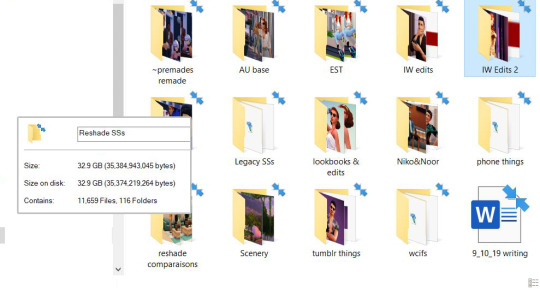
yep. 32.9gb of screenshots & related things...
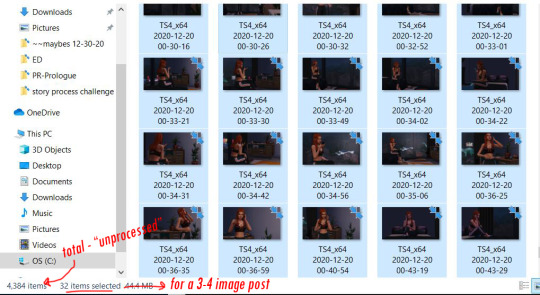
So with the raws from a single random scene selected, you can see i take roughly 10 screenshots per image posted. not terrible i guess but i’m working on it. Typically I take screenshots and once I’m done editing a scene I’ll move them from the general folder to a more specific project folder.
6. Captions - I’ll answer this in three parts:
for my townie story. not really. I prefer using the text box. I tend to write (& re-write) the dialogue for each one of these scenes several times over as I add more “scenes” into my drafts. It would be incredibly inefficient, time consuming, and would waste a lot more space on my pc to have to save .psds of each image just so i could edit dialogue when I decide: “oh hey maybe so and so needs to bring up X in this scene” and then change my mind an hour later.
for niko, noor, & co. I’m a text on image type gal here. don’t really know why, but it gives the project a different energy. ironically it makes it feel more laid-back to me. which i guess makes sense, it’s a much more light-hearted “story” than my townie project. which is, imo, very soapy haha.
for legacy stuff. all text goes below the images in the text box. reasoning: it’s gameplay, I don’t brainstorm, outline, or pre-write for this. I play the game, take screenshots, plug ‘em into my drafts and write some commentary / dialogue to go along with it.
7. Editing - i am a creature of habit and have not majorly changed my editing process in probably a year and a half (when I began using reshade and had to adjust my color correcting psd). it’s a super basic system:
drag & drop my “color correction” psd.
run actions in ps. (i made my own “all-in-one” actions to really streamline the process; i have different “actions sets” for my premades’ story and for other things that get posted to tumblr. even if no one else notices it, i like the little details that keep my projects separate and “identifiable”.
voila. all set to upload.
sometimes i crop images, add “text effects”, or do more in depth editing (i.e. editing a phone screen or adding rain etc.) but overall i try and keep it simple for myself.
8. Throwback - i posted an image of one of the first (but never posted) scenes I’d written for my townie project up above. but as for how would i redo a scene i’d already posted. well i’m currently re-doing my townie story so i guess i’ll just say you’ll see how it’s redone when i get to part 1! 😉
anyway, no tags because i’m so embarrassingly late to this party but if you hadn’t gotten around to this tag, wanted to do it but didn’t get a tag, or started it and left it to sit and now you’re thinking “oh god that was months ago should i even post this anymore?!?” consider yourself tagged by me and go ahead and post it for all to see!
#tag train#story process challenge#it's long. it's rambly. but that's me.#this one was a challenge! a challenge but fun.
8 notes
·
View notes
Text
Breadsticks & Staplers Reflection
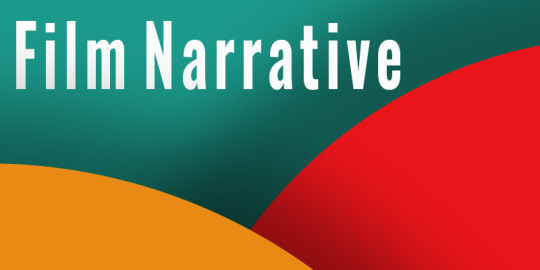
This is a reflection on the recent Independent Project I did for Film Narrative 2.
I just want to say I’d recommend looking at a previous post of mine for context on the work I contributed to this project. Here is the post I believe: Group 7 Independent Project!
- your contextual research - your influences and inspiration.
I began my research into our project by playing a video game titled, “What Remains Of Edith Finch.” It is a collection of strange tales about a family in Washington state. One member of this family is named “Lewis” and his story about being consumed by his maindane life and escaping to this imaginary world played a major influence in the creation of this film. We wanted to separate the imaginary world with reality as much as possible and planned for it all to be animation so we looked at animated films that could serve as inspiration. Films like “Fantastic Mr Fox” and “Spirited Away” really stood out to me as their locations and tone were very much what I was thinking for the project. We began to look at cinematography and Bonnie was particularly drawn to Wes Anderson because of his perfectly symmetrical worlds he creates so we looked at his film “Moonrise Kingdom” You can see the inspiration in the shots of the film and in the storyboard. Additionally, for the costume one of my major inspirations was “Big Fish” starring Ewan MacGregor. His costume was perfect for what we initially planned David to wear however as we progressed we realised we didn’t have a bright blue suit so we had to cut down his outfit to still get the feel we wanted but just with different clothes.
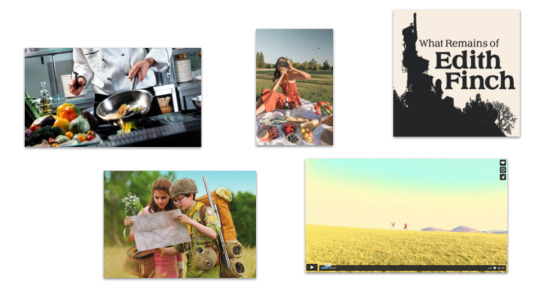
- Your process - What was your contribution? Which elements of the group submission did you author? Which did you contribute to?
My role within the project was Production Designer, however, I did the VFX for the film as well as shoot the film as well. Firstly, I wanted to produce as much work as possible so I could be as prepared when going onto set. So I worked on three areas: Mood boards, costume and set design. The mood boards for me had to capture the tone and atmosphere of both settings and I worked with the group to make sure we all agreed with it. The dream realm is light and colourful with a whole load of colours whilst the office space is very desaturated and absent of colour. When it came to the costume I worked with both actors to get a costume they felt comfortable wearing and suited them best for the part. I sat in video calls with them looking at different outfits to see which one worked and didn’t. I wanted Kady to have an outfit that screamed untouchable. With her large amounts of accessories it feels distant from standard, everyday clothes and I think it worked very well. In regards to David, I had a challenge, we had to find a costume that was what the group wanted (blue suit) however, do that without a blue suit. We ended up cutting away from the actual suit and instead tried to have him look similar to his office self with some extravagant changes like the bold coloured tie and no glasses. Finally, with set design I prepared weeks in advance by setting up the picnic and then also setting up the office space (which is actually blocked off by two ping pong tables) This meant I would take photos of both pre-made sets and then send them to the group for changes and confirmation. I really enjoyed setting up the scenes. I got the idea from Andrew (my teacher) who suggested going to locations before filming and taking photos similar to the ones you would film on the day. It’s the same principal but just for set design and I’m glad I did it.
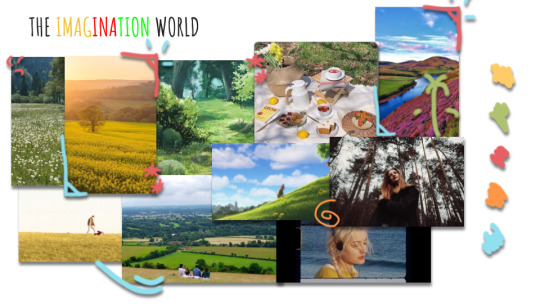
I did VFX as well. This was a challenge as I hadn’t prepared for doing them as we didn’t realise how heavily involved they were gonna be in the final product but I’m glad I took the time to work on them. The match cuts were fairly simple however the shot that transitions through the image was challenging. I was 70% sure it was going to work so when it did I was very happy. It took a couple of drafts and I got Jack to give me feedback so overall it went very well.
Finally, I shot the film as well alongside Jack as director. He would inform me of the shots we had to do that were provided by Bonnie and then shoot them. We used my GH5 and I used my Rode Video mic Pro to record audio for Tom to work on sound with.
- What feedback have you received along the way, on your script and in the crit. What made sense? What didn't? Would you do anything differently?
The most important feedback we received throughout the whole process was on sound design. We were very much focused on the visual aspects of our film and whilst I’m very happy with the work Tom did on the sound for the film I do believe we should have spent more time on it. One thing that was mentioned to us was layering, when it comes to the later half of the film I do believe we achieved a really good amount of visual and audio harmony, however at the beginning of the film it should have been more layered. Jack was certain that we didn’t need music for the film and even though I did think it would be better with music, I agreed with him. I believe we were right to go with the no music approach due to the fact we have been taught not to rely on music to carry a scene and it challenged us to create a detailed amount of sound design for the project but it was suggested to add music to give the film a more Disney feel which I can also understand.

We also received feedback on the editing. Overall people who watched the film were pretty happy, however, we discussed a lot within the group the opening shots of the film. For me it didn’t flow particularly well as it went from wides to close ups for no real reason but after discussing it with the group we found the best shots to move forward with and received excellent feedback in the final crit.
In regards to animation, just before the final crit we showed the film to a friend who said that the animation didn’t add anything to the scene. We understood his point, however, it has been an important piece of the film since the start. We took the feedback on board and scrutinised each bit of animation trying to see if it improved the film and in the end I’m glad we kept it in.
- In what ways did your group work well? In what ways could it have been better?
I feel compared to the first time we were in this group this item has been a lot more collaborative. Even though the first time we were bouncing ideas off one another I believe this time our roles worked better. We all worked as a team and came out with a film I’m proud of making. We made sure we improved off the fiction project by having more meetings, creating sharper deadlines and always offering each other's help. I just felt we improved overall so much compared to the first time. My only gripe this time was that as we finished the shooting of the film I didn’t feel as if we were as focused compared to pre production. It took a bit of time to get the ball rolling and therefore this caused us to rush at the end. Next time I would try to keep up the momentum of production and get it finished as soon as possible so there is plenty of time to make changes.
Conclusion
Overall, I think we did very well on this project. From the feedback we gathered people seemed pretty happy with the film. There is something to be desired in the sound and I will make sure I try to emphasise sound as much as visuals next time (especially as this task asked them to go hand in hand) I do feel we really tried to experiment with this project and that has been notices with the feedback given to us in the final crit. It was a pleasure working with everyone in the group and hope I can again!
3 notes
·
View notes
Text
BnHA Chapter 250: Why Is This Family Not in Therapy
Previously on BnHA: Fuyumi invited everyone over to Camp Todovid for a wholesome family meal because what could possibly go wrong. Kacchan and Deku proceeded to spend the evening blinking distress signals at each other in Morse code while Natsu shoved breadsticks into his purse and skedaddled after getting mad at Endeavor in a completely unexpected turn of events which absolutely no one could have foreseen. After dinner, Shouto had a heart to heart with Fuyu (and then Deku) about whether or not he was ready to forgive his dad, and meanwhile Endeavor said a prayer for his very dead son Touya. Poor Touya. He was such a nice boy. You know what he really used to like? Messenger bags. He’d put the oddest things in them, too. I wonder if Touya would still enjoy collecting strange and disturbing things in bags if he was still alive today. Alas. We’ll never know.
Today on BnHA: Some guy named Takami who just got out of prison decides to show up out of the blue and fucking kidnap Natsuo because WHY NOT. But before that happens, we get a nice scene of Kacchan and Deku sitting down with Shouto and Fuyu, who finally decide it’s high time they talked about THEIR SECRET DEAD BROTHER seeing as LET’S BE REAL, THAT WAS THE WHOLE POINT OF THIS DINNER TO BEGIN WITH. So basically, (1) he’s definitely dead! For sure! 100% deceased!, and (2) Natsuo apparently blames Endeavor for his death, lol no big. Deku and Kacchan are for some reason super fucking chill about hearing this, and then Endeavor comes over and is all “TIME TO HEAD BACK” and omg I’ve never hated him more. And then as they’re driving away from Todofield Hall, Takami shows up and is all “HEY ENDEAVOR LOOK I KIDNAPPED YOUR CHILD AND I’M GONNA KILL HIM!” and holy shit but Horikoshi is just fucking with us now, though.
(As always, all comments are my unspoiled reactions from my initial readthrough of the chapter. I did a quick edit for grammar and clarity afterward, and added some ETAs in the process, but aside from that there are no changes.)
all right manga, do your worst. I’m completely spoiler-free on this one. watch it not even be a flashback, after all of that lmao
(ETA: lol I read these two asks after I read the chapter and they’re pretty great:


honestly this week wasn’t that bad, though! the worst part of it was the whole “only 13 pages again” thing honestly. next week, though, it looks like we’ll be in for some fun times. oh goodness.)
so it appears night has fallen on Todofield Hall, and hoooooooooly shit you guys, are they. are they all gonna have a sleepover at Shouto’s house, because fdszllk I. I’m gonna. ldskfjla
(ETA: [kicks Endeavor in the shins] why do you hate fun!?)
who is talking?? are these prison stripes??
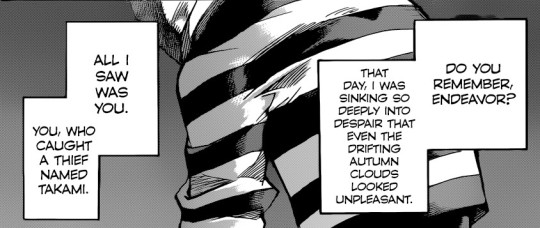
so is this the Takami guy narrating, then? just like we all predicted last week. ???
(ETA: so I saw all these people going “wtf is this Hawks’s dad??” and I was like “lol what” and it took me longer than I’d like to admit to put two and two together, but anyways, long story short, “Takami” just so happens to be Hawks’s recently revealed surname (with the same kanji and everything -- 鹰見). so while every instinct in my body is screaming at me “gtfo no way they’re related”, it is an extremely bizarre coincidence, so uh. ?? I got nothin’, basically.)
WHAT THE FUCK
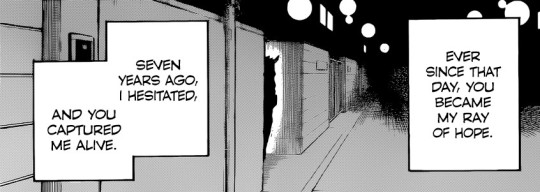
IS THIS GUY STALKING THE TODOROKI HOUSE. ABOUT TO BREAK INTO TODOFELL IN THE DEAD OF NIGHT WHILE MY CHILDREN ARE ASLEEP!? CAN THEY JUST NOT CATCH A BREAK
also I will never understand villains who get all smug about being captured alive. “your one mistake was not killing me when you should have!” like okay, so you’re admitting you’re a piece of shit who should have died, and that the hero totally could have done it, but they were nice enough not to so SHAME ON THEM, apparently
anyways I really don’t understand what’s going on at all lol. some guy looked up to Endeavor and then got himself captured by him for some reason. let’s continue I guess
oh lord it keeps getting creepier
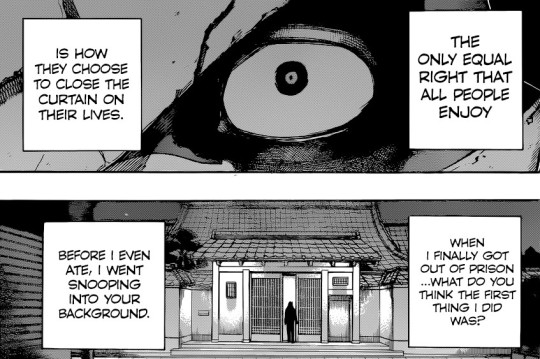
-- oohhhhhhhh shiiiiiiit, is this fucker about to air Endeavor’s dirty laundry?? is that what this is about?
AHHHHH
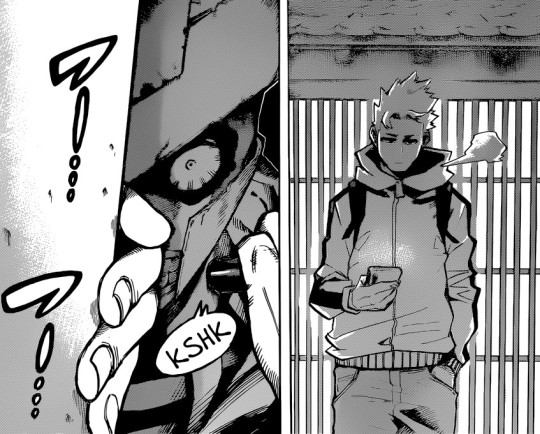
NATSU SWEETIE WHERE ARE YOUR SELF-PRESERVATION INSTINCTS?? IT IS NOT SAFE! and also what the fuck, does Endeavor just not have any security in his home at all? surely he must, if for no other reason than the fact that HE HAS KIDS and he’s not always at home! I have to imagine that any pro hero with a family understands that they’re a potential target for villains and would take precautions. I wonder if we’re about to see this sneaky guy get wrecked
(ETA: nope, Endeavor really has no security whatsoever and Natsu got snatched while waiting outside for his Uber. I’ll give him the benefit of the doubt and assume that he was too busy missing his brother and being sad to remember that he actually has a quirk himself. c’mon Natsu.
-- actually, come to think, props to Horikoshi for once again bucking the trend and having a guy be the one who gets kidnapped and becomes the damsel in distress. I’m just going to assume that had Fuyu been the one to get captured, Endeavor wouldn’t have even heard about it until he received a text from her with a picture of the guy encased in ice and a caption asking “so dad, uh, what should I do with this?”)
BUT FIRST, WE’RE CUTTING BACK TO THE TODOROKI KITCHEN, WHERE TODOBAKUDEKU ARE CURRENTLY HAVING TEA WITH FUYU BECAUSE SOMEBODY UP THERE LIKES ME YESSSSS
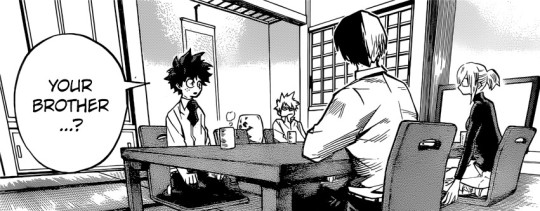
hhhglkohhhhh myyyyy godddddd
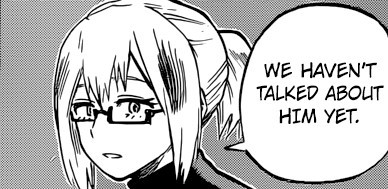
I KNOW!!! WHAT’S WITH THAT! WE’VE WAITED 250 FUCKING CHAPTERS PUTTING UP WITH YOUR SLY-ASS HINTS ALL “ALL RIGHT THEN, KEEP YOUR SECRETS” but is it finally time now? IS IT??!
Shouto says it’s not exactly an easy topic to bring up, and okay, fair. buuuut also, this is the same child who ambushed Deku in a corridor back when they barely knew each other and was all “let me tell you all about my dad’s quirk marriage and how he abused me and my mom and how I got this scar” so like. what exactly do you consider “easy to bring up” though
OH MY GOD IT’S HAPPENINGGGGGGG
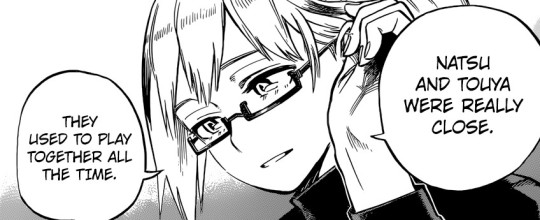
we’re getting DETAILS. ABOUT. TOUYA’S PAST fkdslfh holy motherfucking shitballs someone pinch me
she says it happened right after Rei got hospitalized, which yeah, we all figured based on the middle school uniform in the photo. so that definitely pins down his age then, doesn’t it? Shouto was six when that happened, so if Touya was in middle school he’d have been between 12 and 15. so it’s very likely then that he was 14, the exact same age as Fuyu, so therefore THE TWIN THEORY IS CONFIRMED! WE DID IT TUMBLR
anyways back to being sad though, because
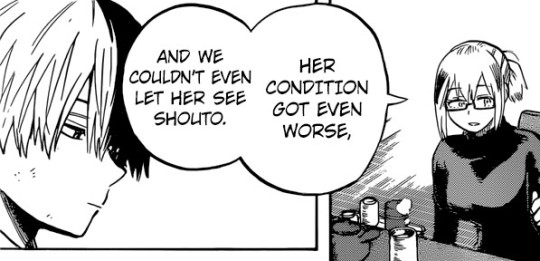
can someone please hug this child?? what are you all even doing?! do you not see his face?? jesus christ
oh no oh my god are you serious are you
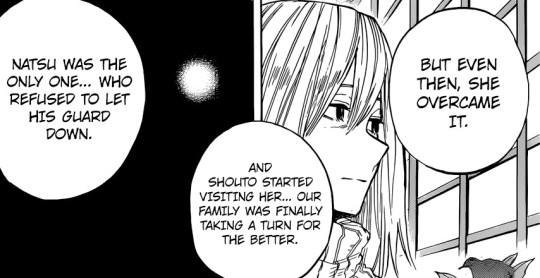
okay, before I go on to the next panel and commence FREAKING THE FUCK OUT, I need to stop here though, because the thought that the Todos actually were in the process of healing nine years ago and could have potentially been spared years of additional pain had it not been for this tragedy is. just. I fucking can’t. I need a minute here. god
anyway. so now on to the freaking out though, because
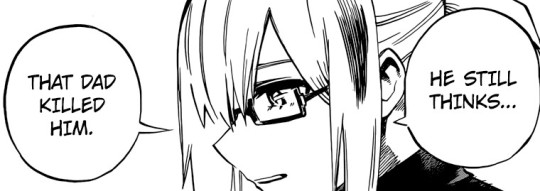
:) :))) :))))))) huh. you don’t say
(ETA: hmm in hindsight I promised freakouts and then all I did was go “:)” but please understand that the “:)” conveys so much more inner freaking out than words could possibly communicate. just picture me screaming and waving my arms around like a Kermit the frog gif okay.)
look at this you guys. this revelation is so stone cold fucking sober that it even got Katsuki to make an actual normal face for the first time in god knows how many chapters, wow
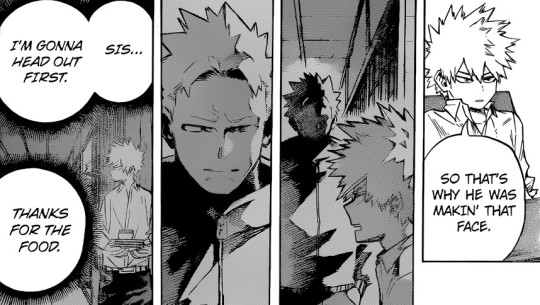
by the way, words can hardly express how much I appreciate that Katsuki is sitting here chilling out drinking tea with the rest of them and listening to this tale of woe and empathizing like a normal, well-adjusted person, though. I will never take that for granted. thank you character development gods. y’all are bros
anyways the face in question that Natsu was making is so fucking sad, and just. THEY ALL NEED HUGS. why is this family not in therapy
NO!!!!!!!!!!!
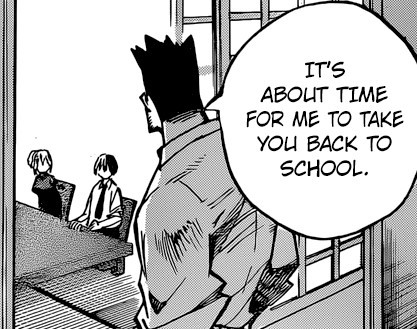
YOU SON OF A BITCH!! JUST LIKE THAT YOU’RE RIGHT BACK ON MY SHIT LIST, ENDEAVOR!! CHRIST ALMIGHTY ARE YOU SERIOUS, SO WE’RE REALLY JUST GONNA LEAVE OFF THERE? “LOL SO YEAH, NATSU STILL THINKS DAD KILLED OUR BROTHER AND THAT’S WHY ALL THE TENSION” and Deku and Kacchan just nod like that is in any way a satisfying explanation rather than an INCREDIBLY OMINOUS STATEMENT which only goes and raises about A BILLION MORE QUESTIONS OMG. “oh okay, so he hates your dad because he thinks that he murdered your mysterious other brother we’re only just now hearing about. say no more. no further context necessary” fucking --
listen, you two. where the fuck are your investigative skills?? SOME SCOOBY SQUAD YOU ARE!!
oh my goodness gracious
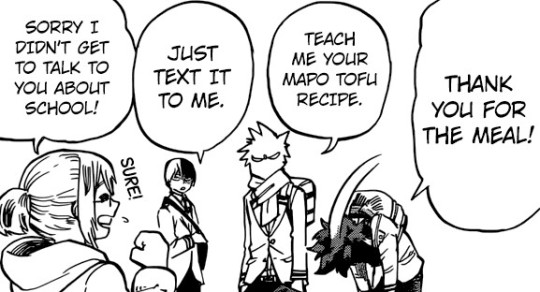
listen guys, things I was not expecting to check off my character development bucket list today: Katsuki joining the Fuyumi fanclub and bonding with her over recipes. I wasn’t even aware that was on my list. BUT IT SURE WAS, AND IT’S CHECKED NOW AND I LOVE IT
also love that Shouto tells Fuyu to just text the recipe to him, and then he will share it with Katsuki. because they are best friends
also Deku is the only one here with any manners at all but oh well. we all been knew
(ETA: though to be fair, Katsuki asking for the recipe is about as big a compliment as one can give to a chef, and it kind of serves as a combination “thanks for the meal” and “everything was really good” tbh. shit, now I want her recipe.)
fdlkjfg
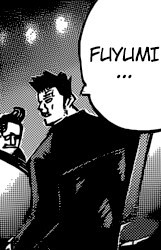
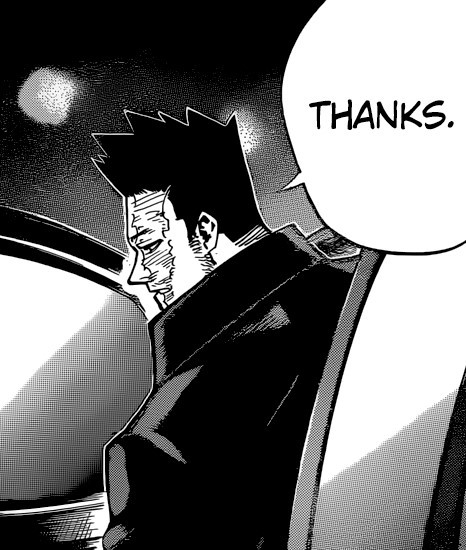
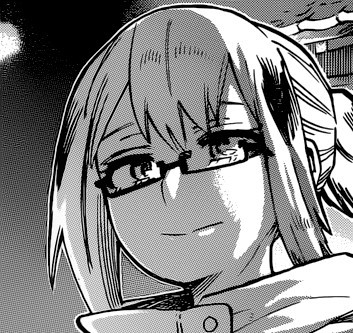
... [reaches out to gently touch the panels] so soft
-- BUT DO YOU KNOW WHAT’S EVEN SOFTER?
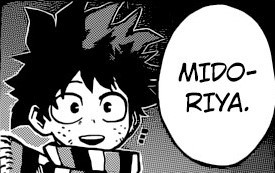
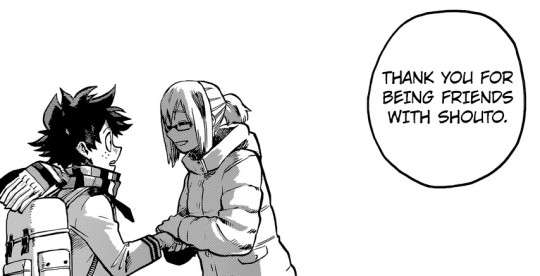
[faint sound of my heart imploding] ah
oh my god his face

and Katsuki’s face too. boy are you jealous. to think you were all “WHY THOUGH!?” coming here, only to walk away from it all with a kickass new mapo tofu recipe as well as a new person to add to your secret list of people you would literally die for. awwwwwww
and Shouto. omg. this is the most bashful panel I’ve ever seen. what a blessed chapter
anyway so now they’re all driving away (back to school?? I think he said?) and Endeavor’s talking to them about their upcoming schedule. so I guess they are heading back to school, then
anyway so he wants them to work the weekend as well as two weekdays? damn that’s a lot of class to be missing, he’s asking them to skip literally half the school week (since they have Saturday class too)
wow you guys look at this panel
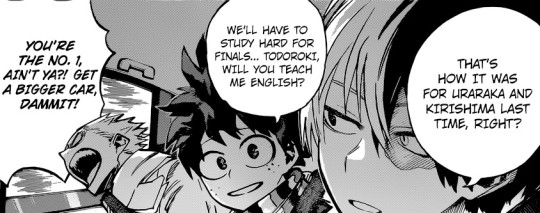
takeaways from this: 1.) I honestly would have thought Deku would be the one tutoring other people in English, if anything. as of the midterms, he was above Shouto in academic rankings, but more importantly he’s also the biggest All Might fan on the planet, and All Might spent a lot of time in America in his youth and presumably speaks decent English himself, so you’d think Deku’s English would be passable just from his obsession alone. but I guess you just can’t beat that fancy private school education
and the other takeaway: Katsuki doesn’t like being squished in the backseat of a cramped Japanese car with Deku and Shouto. this one is absolutely shocking. I’m gonna need a moment to process this for sure. anyways poor Deku, he’s probably getting so many elbows to the ribs right now. I hope he elbows back
(ETA: actually the fact that Katsuki is apparently sticking his head out the window here in addition to complaining about the cramped conditions makes me wonder if he’s actually getting carsick. my poor baby do you need some dramamine.)
guys, meet Endeavor’s chauffeur

so anyway this is a bit sudden but I have a new favorite character now. life is funny like that. does he remind anyone else of Major Armstrong
wow Endeavor is answering the question seriously
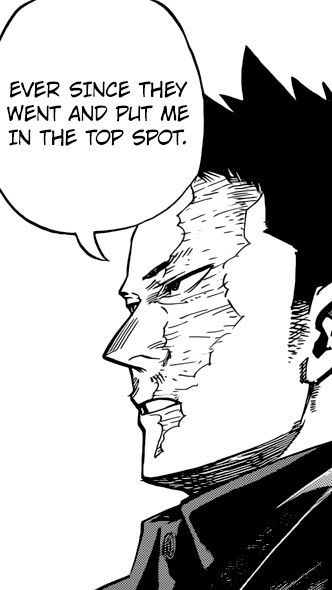
okay but shit, I really fucking love this answer, though. he’s so matter-of-fact about it. because the thing is, the question isn’t really “when did you start baby-sitting a bunch of kids”; it’s “when did you actually start caring about something other than yourself?” and the answer is that it happened when he finally reached the top and realized the responsibility that went hand in hand with that role. it forced him to finally look past just himself, and to think about what it really means to be a hero. shit, I feel another essay coming on, but it’ll have to wait for some other time lol. we still have to see if Natsu’s going to make it out of this alive
anyway so now Armstrong is chuckling and saying that status really does change people huh, and they’re driving on into the night
OH SHIT

THAT’S A NICE SON YOU’VE GOT THERE, ENDEAVOR. IT WOULD BE A SHAME IF SOMEONE... okay you know what, I’m not sure where I was headed with that joke, but in any case I can’t finish it because this isn’t funny at all actually, this is actually SO FUCKING BAD oh shit oh shit
NATSUUUUU

oh no he’s so scared oh fuck. fuck. he’s only 19, he’s just a kid still. god. why do I always get so worked up over these parts. what am I doing reading a shounen manga if I can’t handle seeing kids in peril. HORIKOSHI PLEASE BE KIND TO MY BABIES
holy shit
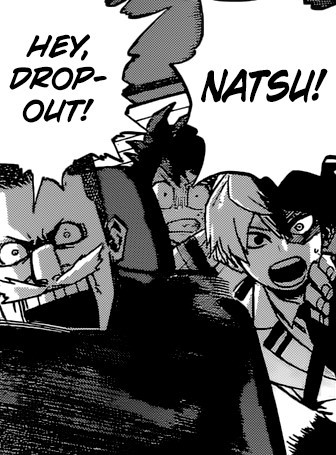
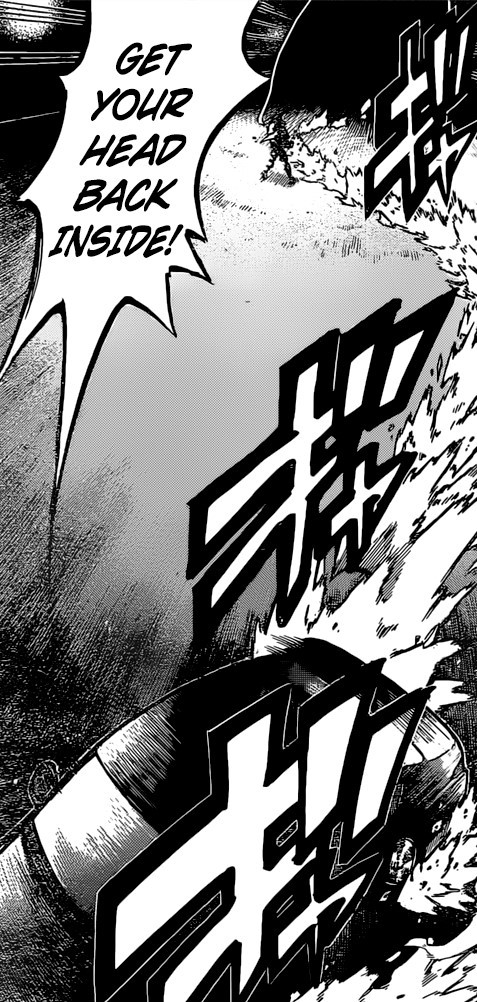
okay, is this implying that Katsuki was sticking his head out of the window in that previous panel?? I realize more important things are happening and this is hardly the time to dwell on this, but jesus christ my kid is out here trying to get himself decapitated. boy what is wrong with you
anyway so now something is going "pop” and I have no idea. ??
(ETA: lol I guess it was Endeavor? you know, how Endeavor sometimes just goes “pop” for no reason. that’s just the sound someone makes when spontaneously bursting into flames.)
oh
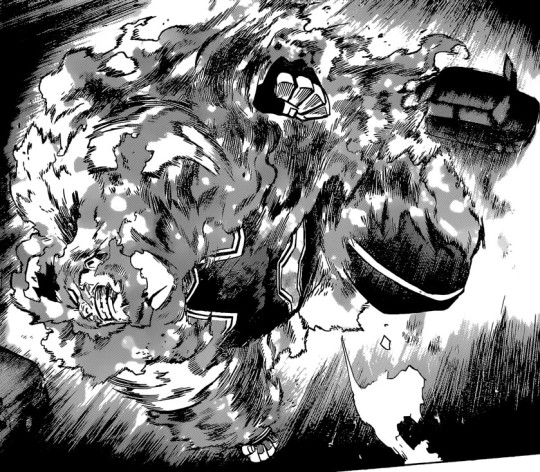
far be it from me to start whipping out analogies about a mama bear and her cubs, but. damned if that ain’t what’s happening though. motherfucker, you mess with his kids? so would you like to die fast, or slow
so now some weird fucking shit is happening to the car, and I guess it’s this guy’s quirk again?

wow my man, so you’re really attacking the car with the three protagonists with SOMETHING TO PROVE in the backseat. you really do have a death wish
(ETA: on top of that, attacking the car mere minutes before the winter break ends, and with it, the deadline for “defeating a villain quicker than Endeavor.” HMMM anybody got some popcorn?)
now Endeavor is shouting “LET HIM GO!” because that’s what superheros shout when someone is being kidnapped
lol poor Natsu looks kind of awkward now
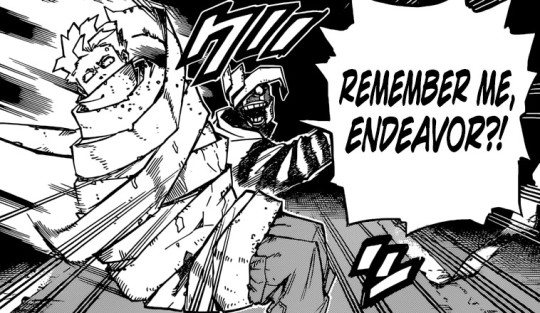
like, don’t get him wrong, he’s still scared for his life. but also he’s starting to get a bit of that same feeling that Katsuki and Deku were getting in the last chapter, like he’s suddenly found himself right in the midst of some grade A melodrama from which there is no escape. anyways don’t mind him, he’s just going to chill here in this big pile of bandages and see where this goes
so Endeavor is all “........... YOU’RE FROM SEVEN YEARS AGO!” and honestly that’s impressive. I guess the quirk is a pretty memorable one, though
wow now they’re suddenly being all coy with this guy’s name? what the hell
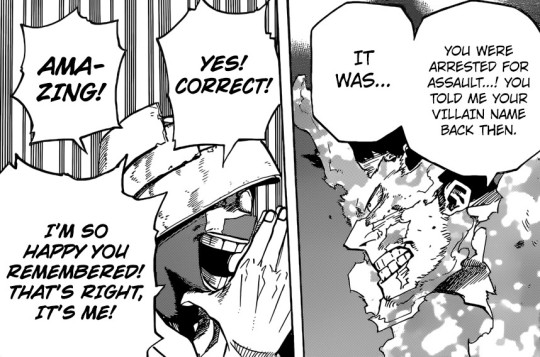
?? Natsu bud, I feel ya, this really is some awkward shit right here
ohhhh!
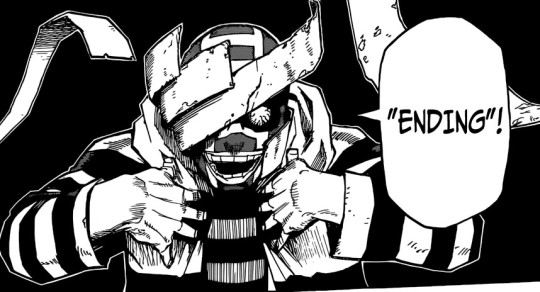
that’s the name of the chapter! well all right then, so at least that much makes sense now
so now Ending is apologizing to Endeavor, and wow, tons of essay fuel in these next two panels here
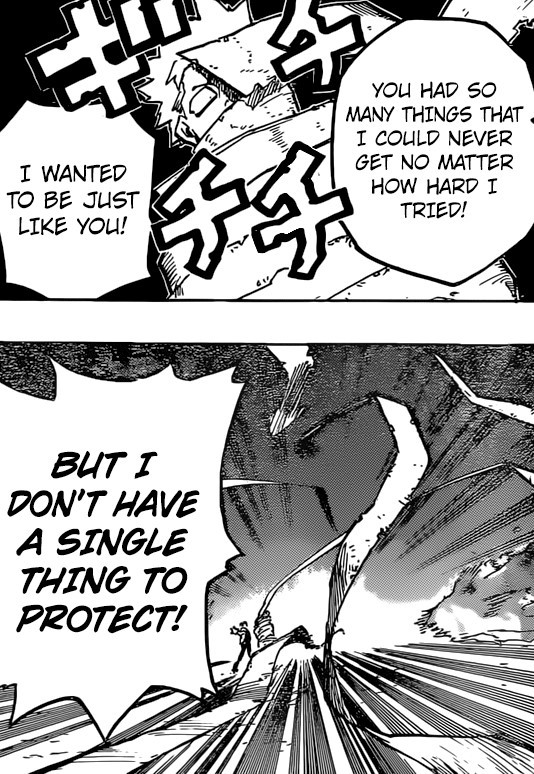
“you had so many things that I could never get” doesn’t this sound remarkably similar to Deku’s speech to Kacchan during their second fight at Ground Beta? huh
and also, I think we are slowly dancing closer and closer to the Thing Katsuki Lacks That He Needs To Learn From His Internship From Endeavor. what do you guys think? I have a lot of thoughts about this, but again, I’ll save it for another post seeing as shit is hitting the fan right now and all
OH SHIT

ARE YOU SERIOUS, OF ALL THE TIMES TO HAVE ANOTHER THIRTEEN PAGE CHAPTER! HORIKOSHI YOU ARE FUCKING KILLING ME HERE
well shit. okay so when he says “don’t make the same mistake twice”, he’s clearly talking about Endeavor letting him live the last time they met, but also I can’t help but feel like there might be some kind of double meaning here as well. the fact that he went from theft to kidnapping and attempted murder, on top of him mentioning earlier about how he went digging into Endeavor’s past, makes me wonder if he could possibly be trying to recreate a specific set of events. or is that crazy??
but just, hear me out. what if something similar to this went down before, with Touya perhaps being taken hostage by a villain (though it couldn’t have been the same guy because the timing is off, and also Endeavor didn’t recognize him right off the bat), and Endeavor making some critical mistake which resulted in him failing to save him, and Natsu then blaming him for that and holding him responsible for the death. honestly that makes the most sense to me, since I would think that “literally murdered his own kid” would be kind of a deal-breaker as far as the rest of the family ever reconciling with him. so yeah, this could get very interesting here
(ETA: hoo boy, so I’ve been browsing the bnha tags a bit, and it seems that a lot of people are interpreting the hints in this chapter very differently from me lol. I admit I could certainly be wrong about the “don’t make the same mistakes” bit having a double meaning. but like, do we really believe that Endeavor just straight up murdered his son and got away with it, or that it was covered up or something? or that he drove Touya to suicide? I think it’s much more likely that Touya pushed himself too hard, or that he accidentally got caught up in one of Endeavor’s attacks, or something along those lines.
what really struck me, though, was that a lot of people actually seem to be hoping for it to come out that Endeavor really is responsible, though. like, to the point where they’re prepared to be outraged if it turns out he’s not, and this part of the story doesn’t end up conforming to the narrative of Endeavor just being a sinister cartoon villain. and like, I don’t really know what to say about that. except that I really hate this idea that if an abuser is ever portrayed as something other than a heartless monster then it’s super-problematic and/or just bad writing. that Endeavor not murdering his son = Horikoshi endorses child abuse. or something. anyways I don’t have the spoons to really throw my hat into the ring here, but basically my opinion is that life is rarely just black and white in that way, and this story reflects that, and I think it’s absolutely the right call to make and is actually very good writing and I respect it.
and also like, it’s not some all-or-nothing thing here where he’s either a perfect saint, or the worst person to ever exist! what he is is a man who made some terrible choices in the past and abused and hurt the very people he should have loved and protected the most. and what he is, also, is a man who has realized the awfulness of the things he’s done, and is trying his best now to be a good person. what he is is a human being. and acknowledging that doesn’t mean that you condone the abuse; it simply means that you acknowledge that people are made up of more than just the worst things they’ve done in their lives. that’s it.
anyways, for all of my “not gonna through my hat into the ring” nonsense, I’m doing a pretty good impression of exactly that, so I’ll shut up now. damn you Endeavor and your controversy-sparking ways. what kind of psychopath looks at the fucking BnHA fandom and says “not bad, but you know what this place could use? more discourse.” you knew exactly what you were doing, you fiend.)
anyways I’m going to hope and assume that Natsu isn’t actually about to meet his end here at the hands of this bestriped man and his peculiarly thematic villain name and sinister bandage arrows (are they bandages?? maybe not since they seem pretty solid and he’s threatening to stab Natsu in the eye with one. idk). and for all of my joking earlier, this guy actually does appear to have a real, genuine death wish since he keeps talking about how Endeavor should have killed him before. so in addition to all this other drama, toss in an attempted suicide by cop as well! this fucking arc, man. goddamn
#bnha#boku no hero academia#bnha 250#endeavor#todoroki touya#todoroki natsuo#todoroki fuyumi#todoroki shouto#bakugou katsuki#midoriya izuku#bnha spoilers#mha spoilers#makeste reads bnha#'let's all have dinner together at icyhot's house' they said#'it'll be fun' they said#didn't even get to finish his gd mapo tofu#got shouto's creepy brother staring at him in the dark#and then this whole thing with his other brother who's apparently f***ing dead because of course he is#and icyhot's stupid sister thanked deku for being his friend but not him!#and then he was crammed back into this tinyass car again with these morons#and now the goddamn brother has been taken hostage because of course he has!#what did katsuki ever do to deserve this#sorry kid
137 notes
·
View notes
Note
what goes through your mind when you begin to craft a scene? a series of images that you nail down with words? getting a character from understanding A to understanding B? a particular emotional response you want to incite? any and all thoughts on the matter are greatly appreciated. thank you in advance! (2/2)
This says 2/2 but I did not get a 1/2?
I write linearly, so my first thought about every new scene is, “Okay, what happens next?” Once I have an answer to what happens next, I ask, “Is this real time or summary?” To answer that question, I sometimes have to ask, “Is that interesting?” And if the answer to that is yes, then sometimes I have to ask, “Is it relevant?”
This is a little backwards, because really I should be asking “Is it relevant?” first. Even if it’s interesting, if it’s not relevant, it shouldn’t be in the piece. This is how you help keep tight pacing. However, I have to say with fic I am just not terribly concerned with pacing. I’ve said it before, but it really shows in my fic. But a big part of the point of fic, for me, is not necessarily to write a well-crafted story, but to show a lot of stuff in and around stories crafted by other people. Therefore, even for a story that occurs completely post-canon and is self-contained within its own plot, I am still not as concerned with pacing as I would be for something original.
But what then do you do if what happens next is relevant, but not interesting? Sometimes this happens, because certain things need to happen for the plot to work but they’re not huge plot points. That means you can usually cover them with a summary. Summaries themselves need to be both interesting and relevant, but usually you can make whatever happened next interesting because when you’re summarizing, you’re packing a lot of info into such a small space.
If what happens next is neither interesting nor relevant, I just keep skipping ahead through time until I get to something that it is either interesting or relevant or both. Then I decide whether I need to add a bit of summary to indicate time passing or whether I just stick in a jump cut.
Once I know what happens next, I usually just start writing. I usually have the overall shape of the story in my head and quite a few ideas for what needs to happen, but if I plan just one scene ahead of time I’ll get super stressed about following the plan, which will make it really stilted. So I just start writing and go, hoping I get out something relevant and interesting. Sometimes I do have to delete it or change it into a summary after all because it’s not enough of either, but lots of times a weird something takes over and things just happen.
That’s really the only scene planning I do most of the time. Re: your suggestions--I almost never have images in my head, so I never worry about those. I never think about what emotion I want to incite in the reader because if I think about what the reader is feeling rather than what the characters I’ll feeling, I’ll get off track. I definitely think about getting character from understanding A to understanding B, but I usually don’t think about it while beginning the scene--I hope it happens and then have to go back and edit or rewrite or rethink what’s happening after I’ve already begun writing the scene.
Every once in a while, I have to go back and add a scene, so I’m not writing linearly, except my thought process is almost always the same: what is the literal character concretely doing in their life right now? Like if I realize half way through writing something that Draco and Harry do not feel emotionally close enough to kiss when they need to kiss, I go back through the earlier scenes and say, okay, how can they meet up again so they can have some interaction that furthers their intimacy? It’s all concrete stuff like, do they go to a pub? meet at a clam bake? babysit Teddy? I tend not to think too hard about what they need to say or do to achieve the intimacy; I rather think, “What concrete thing can they do for long enough where they would stay in the same room together so that whatever emotional beats I need to get to can be struck?”
So it’s all very literal and straight forward and there is WAY too much thinking “and then they brushed their teeth and went to bed,” and “and then they woke up the next morning and showered and got dressed and had breakfast and went to work” before remembering to skip all that.
25 notes
·
View notes
Text
My Creative Collaborative Project
Initial ideas and creating “Combined”
When embarking on this project, my group was initially much smaller, consisting of just three members (Victoria, Oliver and myself). After brainstorming, our initial ideas were to create a party themed piece of film like a music video, to show the more fun and social side of dance. However, as we progressed further with the process, we struggled to continue as a three. Our ideas were limited and to create the party atmosphere that we hoped for proved difficult with only three members in the group. It came to our attention that another group was struggling with a similar situation. It seemed ideal at the time to combine groups as many of their goals and ideas were similar to ours. They were focusing on how dancers can often use dance as an escape from what might be going on around them in other aspects of their life. Although the industry can be a competitive and a confidence lowering place, we wanted to focus on the complete opposite side of it and remind ourselves and our audience why we and so many others love it. Therefore, we joined groups and created “Combined” (Victoria, Oliver, Ben, Adrienne, Rose, Eloise and myself). This immediately appeared to solve our initial problems, helping us to proceed with the flow of creative ideas and also opened up more possibilities due to the larger group.
Working as a larger group
It was not difficult to merge the groups as our concepts were very similar and we were able to combine our thoughts and ideas to create a vision for a piece that we were all happy with. The members of the group that we had combined with are all from the musical theatre pathway, and therefore they wished to bring their music skills and knowledge to the piece. Adrianne had been working on an original song that had a similar inspiration and message to our ideas. The song was about having someone or something to pick you up when you are down and, in this instance, we could relate this to our idea of dance being an escape from other issues people may be experiencing in everyday life. We decided to stick with our initial idea of a music video and as a group we decided that we wanted to make the choreography quite hip hop based as the song is very upbeat and pop influenced.
Creative process and inspiration
In the early stages of developing the piece, we liked to put all our ideas into mind maps and story boards on a big white board. It quickly became clear to us that we wanted three main characters, each with a different issue going on at home and through the story to show how they all come together at the end and are able to escape from their worries and problems for a little while through dance. I thought it would be a good idea to start the video right from the beginning of their day when they wake up, as I know that if I have a worry or concern it is always the first thing I think of as soon as my alarm goes off. We decided to film the three characters in the same house and doing the exact same things as it highlights the fact that they are all experiencing similar situations, and although they are different people, they are not alone in their problems. Using a split screen helped to emphasise this.
To strengthen the idea of dancing being an escape and having a positive influence on people’s life’s we continued to look at the party atmosphere and vibes that we wanted to create. We decided on having a big fun section of choreography (choreographed by Oliver) to the chorus of the song, where everyone comes together to dance, party and have fun. To create the feel-good party atmosphere that we needed, we took inspiration from a few music videos that we believe create a similar feel. These videos were- “Love on Top” by Beyoncé (Beyoncé, 2011) and “It’s My Party” by Jessie J (Jessie J, 2013). Another piece of inspiration that we took was from the quote- “Dance, when you’re broken open. Dance, if you’ve torn the bandage off. Dance in the middle of the fighting. Dance in your blood. Dance when you are perfectly free.” (Barks & Moyne, 2012)
This quote comes from a translated poem, originally written in Persian by Rumi. Rumi was a 13th-century Persian Muslim poet, and lots of his work has been translated from Persian into many world-wide languages (Awaken, no date)
We took from this that dance could be the answer to all problems and situations that we find our selves in as humans. It might not solve the problem or get you out of a situation, however, it will allow you time to help figure it out or escape from what’s going on, and sometimes that’s all we need.
Before it came to filming, we needed to decide on location and costume. We decided to film the opening scene in a bedroom as the characters wake up, we needed a room that had good natural lighting and after analysing our options, we collectively decided that Ben’s room was most appropriate. We then decided to film the second part in college as it is a place that links everyone together much like our reoccurring theme of dance linking everyone together. Victoria came up with the idea of everyone wearing something denim as it is quite plain, uniformed and would look good as a collective for the party themed section of the video. I also came up with the concept that everyone has and owns something denim, which also helps to convey our theme of everyone having dance to bring us together; it’s something we all have in common.
Some of our story boards and mind maps from the early development stages:
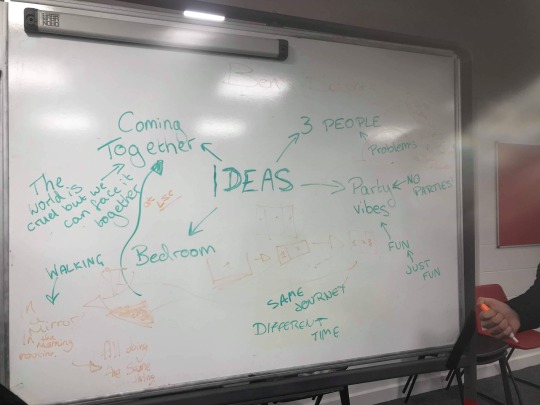

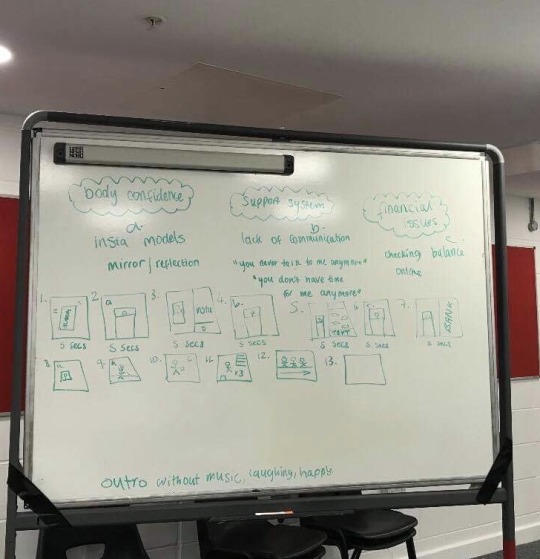
Filming difficulties
Prior to this point in our creative process the majority of producing work had run quite smoothly as there had been very little disputes and having a larger group meant we had lots of ideas and skills to work with. However, as we began the filming process, we started to experience difficulties. We planned to film the video in two shoots as we had two main locations. The first part of the video was filmed and edited easily, as we had planned well in advance what date we were filming and who was going to be involved with what. Nevertheless, when we came to film the second part which was the party section where everyone was supposed to be involved in, we experienced difficulties. Some people in the group couldn’t make it at short notice and others didn’t turn up. This was unfortunate for those of us who did turn up as some of us had taken time off work specifically to film. We did arrange the filming date really far in advance so everyone had plenty of notice, but for those of us who were there, we used the time to work on the choreography instead. We then had to delay and film much later in the schedule, which meant that we had less time to film as we had to get it all done it one evening after class.
The initial idea was to shoot some shots outside that day when it was light, however, these had to be cut due to the rescheduling to the evening. This rescheduling also caused difficulties for Rose who was filming and editing the piece, because this meant that she had less time to edit the video the way she had planned to and added extra pressure to her role.
Eloise was unfortunately ill on the day that we filmed the “party” section, and even though she was one of the three main characters in the first section of the video, we made the group decision to go ahead and film without her and I stepped in and played her role in a few shots. The switching of actors did nothing for continuity and will add a little confusion for the viewer. At the time we made the decision, it seemed like the logical thing to do as we wanted to have a finished product on time and had already had one delay. We also had imagined the “party” section to have a lot more dancers than we did. When we advertised that we needed extra dancers, it was probably too short notice as we had little interest from people.
Whilst filming in Arts Depot we were approached by a member of staff who said if we wanted to continue filming, we would have to fill out a form called a ‘Film Permit Application’. We had not considered that this would be necessary, and thankfully they were very relaxed about it but if we had been somewhere else, they may have been much less understanding which would have caused complications. In future, we would have to consider allocating a location manager in future to organise this kind of details, and to avoid complications.
Below is a photo of the Film Permit Application that we had to fill out-
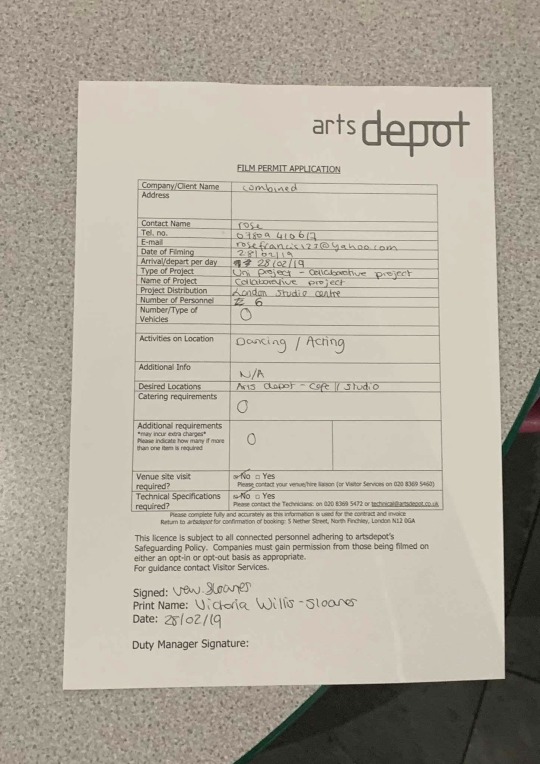
My Contribution
Our project was very much a group project, although a few people fitted in specific roles like Oliver as the choreographer and Rose as the videographer/editor; they had more experience in those roles and it seemed fitting. There was no real leader and no one was overbearing, at times different people took charge if they had an idea and we all allowed each other to voice opinions. We didn’t really distribute strict roles, which was risky but it meant that no one was worried about stepping on each other’s toes and were able to give opinions and ideas about all aspects of the piece. This approach worked well in the end and it really reflected our group name “combined” as it was a combined effort. Personally, I am quite a shy person and would usually take a step back and be scared to contribute ideas and opinions in a group project, however I enjoyed giving an input and building my confidence to have my ideas heard, specifically in the initial ideas and creative process stages of the piece development and also during filming. I believe that although we experienced some difficulties and complications that may have affected the final product, meaning that it is not exactly as we had imagined it, we have created a music video that we are all happy with.
Message to the audience
We believe that the dance world has a reputation that it can be a very stressful and confidence knocking place, and behind all the glitz and glam there is a brutal side with negative connotations. We want to remind ourselves and the audience that many people use dance as a way of escaping and finding a sense of belonging. We want the audience to understand that dance can act as a support system for people experiencing non-dance related problems in their everyday life. Whether their issues are big or small, it doesn’t matter because dance brings everyone together and although we may not know it, we are all going through similar things under the surface. We are stripping back dance to its routes and presenting the social and enjoyment side.
Bibliography
Awaken. (No date) Rumi. [Internet] Available from: http://www.awaken.com/2013/02/rumi-2/ [Accessed: 12 March 2019]
Barks & Moyne. (2012) Dance, when you’re broken open. [Internet] Available from: http://andylal.blogspot.com/2012/06/dance-when-youre-broken-openby-rumi.html [Acessed: 12 March 2019]
Beyoncé. (2011) Beyoncé- Love on top. [Internet] Available from: https://www.youtube.com/watch?v=Ob7vObnFUJc [Accessed: 12 March 2019]
J, Jessie. (2013) _Jessie J- It’s my Party. _[Internet] Available from: https://www.youtube.com/watch?v=59caVlKNNEQ [Accessed: 12 March 2019]
1 note
·
View note
Text
What Happens When you Die?
What happens when you finally die, or in other words, what happens when you finally kick the bucket? so to speak. Despite our mostly science-grounded views on death theses days, it seems that many of us still believe in life after death. In 2014, UK citizens were polled by the Telegraph, and just under 60% of the respondents said that some part of us lives on. Now, in the USA, which still a very christian nation, Pew research in 2015 asked people what happened after you die. The survey found that 72% of Americans believe that you go to heaven, which was described as "where people who had lived good lives are eternally rewarded." 58% of the American adults replied that they believed in hell, which in turn was described as a place "where people who had lived bad lives and have died without being sorry are eternally punished."
It seems that alot of people do believe that after death, we might be ensconced in some cloud-strewn paradise, or conversely, if we failed to adhered to the ethics prescribed to us by our chosen religion, we might face eternal hellfire and the prospect of groveling to a bearded-red man who hardly ever puts down his pitchfork. But let's start with some empirical realism and what actually happens to the body when we die.
Physicians know that you are dead because your heart stops beating and there is no longer any signs of electrical activity in your brain. Brain death equals dead, although machines can keep you going a little bit longer. You might also get what is called a "cardiac death" which means that your heart stops beating and therefore, blood does not flow through your budy anymore. The strange and even wonderful thing is, people who had suffer cardiac death but had been brought back to life said that they were aware of what was going on around them. Others have talked about walking towards a light in such a near death experience.
So you can be brought back to life from what we call "clinical death", but you only have a grace period of about 4 to 6 minutes. But let's assume that you get to the light and pass through; that is what we call "biological death" this means...game over, the final whistle, dead as a dodo. And this is where it get kind of undignified, but what is it to you, you're dead now, remember?, so when you are no longer with us, your muscles relax, that means your sphincter too, meaning that big ass burito you had for lunch will splill out of you, the gas you have inside of you may also leak out and cause a stink. The same goes for the pee you've got in your bladder, so dying not surprisingly is a very messy affair.
You want to know some crazy shit?, men may even ejaculate, and women may give birth after you have died in you were pregnant, which is something called "coffin birth". It doesn't happen oftend though, since instead of pushing, it's the gases in the abdomen that squeeze the newborn into the world.
As the body gets rid of what is trapped inside, noises might be emitted from your mouth as air escapes. Nurses and people working close to dead bodies have regularly reported hearing very alive-sounding moans and groans coming from the dead bodies. You might twitch, but it doesn't mean there is life in you, these are just muscle contractions.
You could also soon get an erection if you die lying on your stomach and the blood flowed down to your pecker. All your blood will pool to a certain area of your body. This is called "Livor Mortis" and it is the reason parts of your body will have that dark purple color you have seen on TV. So this are the lovely things that can happen quite shortly after you go.
With no blood flowing through your body, it will begin to cool down, this is called "Algor Mortis", or simply "death chill". It will keep cooling until it is the same temperature as your surroundings and you will become stiff within about 2 to 6 hours, and this we call "Rigor Mortis". This is because calcium is getting into your muscle cells, cell break down because there is no blood flow and this leads to bacteria growth, and that is why you start to decomopose.
You might look like your nails or hair have grown, but that isn't so, what is happening is that your skin is receding, giving the wrong impression of growth. The skin will loosen too, and blisters will appear on the body.
The following stage is putrefacation, when the bacteria and microorganisms start feasting on you. You will soon start to stink as bad as anything you could have imagined while you were alive...really it is unholy.
Soon, everything that was soft becomes liquefied, with things like bones, cartilages and hair remain strong, you are already on your way to decomposing by the time you are being put into the ground, but if embalmed and buried, decomposition could be a slow process. If you are left above ground, you'd be a liquefied mess within about a month, feasted on by insects, maggots, plants and animals. Underground, some experts say that it could take 8 to 12 years before you are reduce to your skeleton, and after 50 years, you will come back to the periodic table.
While some people report that their near-death experience was a scene to be hold, that's not always the case. One person writting on reddit said tha his experience was as follows:
I attempted suicide a few years ago by hanging myself with an extension cord. I had no pulse when the police arrived but nobody is really sure how long I was up there. I was resuscitated in the ambulance but was in a coma for a little under 2 weeks. Anyway, all I remember is a feeling similar to general anesthesia once I jumped off the table, but for the 5 seconds before it went black, I was in total panic and had a total change of heart from the confidence in my decision to end it seconds before. And then it was just... nothing. Like a deep sleep. And when I finally awoke from the coma, it was like finally reaching the surface of pool after diving too deep. I was in the same panic that I was immediately after I jumped from my table. Like I just blinked instead of being knocked out for 2 weeks. So to answer your question, I don't remember anything at all. It was like being in a deep, dreamless sleep. Perhaps if I regained consciousness immediately after being resuscitated, I'd remember something more interesting, but yea "nothing" is about all I can offer.
Edit: My personal theory is that I didn't have a near death experience like others because I had cut off oxygen to my brain. When I die down the road, I hope I still have some brain activity right before I go. I think Those near death expirences are the brains way of helping someone relax and allow their bodies shut down peacefully, without a fight.
Irish empiricist philosopher George Berkely was so hellbent on knowing what happens after, or those moments fter clinical death, that he actually hanged himself to the point of death, with a friend nearby ready to cut him down before he died. He believed that there was something between Heaven and Earth, perhaps what philosophers have called the ether. The story has become lore in the philisophical circles, but it's thought all Berkeley really discovered was that hanging hurts your neck.
Frederich Nietzsche talked about the concept of eternal recurrence, or eternal return, meaning all existances or energy in the universe has forever an will forever keep repeating itself "ad infinitum." So you get to live the same life over and over again, forever. Another reason for you to want to live well.
Here we can make similarities to the buddhist belief of the "Wheel of Samsara," wherein all souls, lives, will begin in a cycle again after death, except not exact the same life. This is what we called reincarnation, which some people say is connected to what we sometimes called "deja vu." Buddhist believe that we can put an end to this vicious cycle if we can become truly enlightened, therefore achieving "Nirvana."
Or maybe we make our way to heaven after our body stops working, tipping our cap to St. Peter at the Pearly Gates, hoping that he will not deny us entrace for stealing that candy bar when we went on a school trip to Niagara Falls. We will be taken into paradise, a place replete with excellent foods and gorgeous maidens that make your dead knees go weak? or will we simply seed the Earth, our souls nothing more than a worldly fancy that took our minds off our cosmic insignificance and the feeling of futility that we sometimes experience here on "terra-firma"
It doesn't matter what religion or creed best describes you or follow, all of us are slowly or fastly walking to the bitter end, its time to make a change, not only because you think that will buy you a ticket to "Nirvana" or "Heaven", but because in this limited time you wish to make a change, live better and happier, for you and for the ones you love.
Until next time my friend,
https://ift.tt/2Ir2K7I
#What If-Nowadays Interesting Facts#https://whatifinteresting.blogspot.com/2018/05/what-happens-when
0 notes
Text
Evaluation
The first puppet making workshop took place on day one and was led by 2017 BCU graduates from the collaborative illustration group, ‘We agree on Eggs’. This workshop instructed each of the newly formed groups to create one puppet as a team. This puppet did not have to have any thematic significance as the main aim of the task was to create a functioning puppet collaboratively. I believed this would be important for our group to decide on a theme straight away and make a puppet prop that we could utilize for our final performance. I thought this because Jo had mentioned in a previous presentation that our narrative module was fast paced, therefore required immediate creative action. We productively brainstormed many ideas holding the 1968 focus and we all seemed to agree on the idea of portraying a summarised narrative of the life story of Martin Luther King Jr, the movement he created and the legacy that he left behind.
To kick of the group research and get moving with the project, we each had a look into different approaches to puppetry. Shadow puppetry seemed to be the one approach that we all agreed on and saw the most potential in.
For me, the simplistic aesthetic of the shadowed figures was significant for our groups focus in particular. We wanted to highlight a visual tension between Black and white significance that would bestow a solemn and serious message. This is why the age old characterised approach to puppetry such as stuffing/painting may have looked inappropriate. We wanted the silhouettes of our puppets to be simple enough not to be overly decorative, but detailed enough for the audience to know and understand what each image would represent. It was all about getting the right balance.
We moved on from this by allocating and delegating our roles. We began to find out each other’s strengths and also what we each enjoyed doing. I believed it was very important for everyone to have a role that they felt confident in, as the more you enjoy doing a task the more confident your craftsmanship becomes - therefore the more accurately the work develops.
Myself, Mikayla and Jada made all of the handmade puppets individually. I did all of the detailed illustrations for characters as illustrating is my strong point, also something I enjoy doing. Jada made the Martin Luther puppets in order to keep the individual stylized effect and Mikayla cut out all of the large scale handmade puppets.
I wanted to start the story boarding process quickly, partly to get a head start and partly because this is the way that I most effectively go about creative projects. If I have an image to work with or a picture in my head, it’s best for me to get it down on paper in order to re-affirm the strength of my original ideas. It also helps me to communicate to the other team members. Additionally,I found that when you are trying to explain a creative concept to other creative people it is important to describe an idea with as many visuals as possible.
Deciding on a Narrative
We put our heads together and brain stormed by researching some of the most significant events revolving around Martin Luther King Jr’s movement and life story. We initially picked far too many events to re-tell, so with some difficulty managed, to reduce them. The one thing that we all agreed on, is that we wanted the events that we picked to somehow intertwine and flow like a narrative.
I wanted to create a professional level story board, but knew that carrying out this process for every single frame would take up too much time. Instead I decided to pick a key scene, the ‘I had a dream scene’ and mock up how I wanted it to look. I did this digitally on the tablet which allowed me to directly transfer it onto my blog. I found that this illustrative way of working was useful, so continued to draw on the tablet throughout the rest of the process. Once we had each scene sorted, we knew who would create what.
Thinking about how we would perform
On the Tuesday of the second week, Jo asked each of the groups about what approach of puppetry they planned to take forward. This short talk became very significant to the progression of our project. We found out that the majority of the groups planned to do shadow puppetry.
This meant that we had to have an idea that would make our show different from the others. At the start of the module, tutors said that we shouldn’t limit our aspirations for the project and encouraged us to ‘Think Big’.
I had an idea to create an enlarged version of our original theatre. I thought that the scale alone would be very impressive, but alongside that we could get members of the audience to partake and get active with the props that we would make and provide for them.
We have picked two key scenes from our final performance and plan to make ‘human size props’. We plan to set up a tripod at the front of our enlarged theatre so that any member of the audience can film themselves, or their friends experimenting with our props. The concept of the large theatre challenges the audience to ‘physically’ and ‘metaphorically’ take a stand and get involved in the movement that we are exposing them to.
Practitioner research
During this process, I came across the Altered Scale Theatre Company, a progressive puppetry and theatre company founded By Artistic Director and performer Austin Mitchel Hewitt in March 2014. I know Austin Mitchell through mutual friends and contacted him and informed of our brief. Austin has worked on many projects around the city of Liverpool, hand crafting puppets and performing with them for a number of collaborative shows. I corresponded through email with Austin a couple of times, asking him questions about how to progress with our project, asking about the work he has done and just enquiring about general tips and tricks of the trade.
Austin proved to be very helpful and some of the work that he sent me further progressed some of our original ideas.
On my first email to Austin I expressed my concern about background and how I would go about padding out the screen. This was during the making stage of our puppets and we hadn’t actually had time to experiment in the shell with all of our puppets and props. All we had done in terms of experimenting with the shadow theatre, was using the frame that Lee had set up in our work space. Austin advised me that “SIMPLICTY is the key to puppetry… if you have too many visuals all at once… the audience finds it difficult to follow…"
Once my group had practiced and experimented with our own theatre space and used all of our puppets and props in conjunction with one another, I completely understood what Austin was advising.
We really wanted to try and portray the significance of the message and story of Martin Luther King’s movement and if we were to over complicate this with overly elaborate puppets and props, this specific significance would be lost.
I think at first, we thought that shadow puppetry would prove to be simpler than it actually is. We have also found that it takes a lot of time to make something so small. We have decided to incorporate human shadow puppetry for some of the scenes to add a different medium and to reduce the number of puppets that we have to make.
At times, we thought we had created a background prop that would work, but we realised that it had blocked out some of the major detail in Kings body. When Kate and Sam came back we discussed the possibility of using the laser cutter and vectors to create some puppets that had proved to be difficult with paper. We did eventually do this and it did work effectively.
The filming process
On Tuesday 27th of Februarys from 5-9 we had booked the shell, to perform and film our smaller scale shadow puppetry that we are going project onto our cinema screen. We managed to work really well together and naturally found the roles that best suited ourselves. Kate took charge filming, Mikayla, Jada, Sam and I performed with the puppets.
Because we had planned out how we wanted each scene to flow, it was actually a really fun experience. During the process, we found that some angles worked better than others and some original ideas had to be scrapped, but anticipated that.
We were very glad that our filming did not include natural sound, as an essential part of us effectively working together was down to the fact that we could speak to each other from different sides of the theatre and instruct one another on what was working well/what wasn’t.
Despite the fact that we had a really long day and were all tired, I actually really enjoyed the filming process. I learnt skills that I otherwise wouldn’t have known doing my graphics course.
The sound track process
On the Thursday after filming me and Kate stayed back to begin the editing process. We decided from the beginning that Kate would edit the video footage after it had been filmed and once she had done so, I would refine the sound track/sound effects that I had put together on Logic Pro.
For a long time the career path that I wanted to pursue was music, in particular film score writing. I have studied music for a number of years and have learnt how to compose music digitally. So, from the start of this process I put myself forward to do this task. The thing that was so important about our sound track, was that we had no script, therefore wanted the music to relay a narrative. I didn’t want to just put a song together, I wanted to convey a message, so I decided to combine facts with music.
I found a number of significant news reports from the scenes that we re-enacted through puppetry and combined them with music that I considered appropriate. Before starting on the sound track, I instantly knew the tone and mood that I wanted to create and how I would go about writing it. However, I knew I needed the footage next to me when refining timings.
One of the most difficult things I came across when creating the sound track, was getting the timings for sound effects right. For example, the scene in which Martin Luther is assassinated, Sam stands behind the screen and shoots our gun puppet that we made on the first day. It was really hard to time this action with the sound effect of a gunshot simultaneously.
0 notes
Text
ART OF THE CUT with “IT” editor, Jason Ballantine, ASE
Jason Ballantine, ASE (Australian Screen Editors) has been in the film industry since 1992 and is currently living in Los Angeles. He has won and been nominated for several Australian Awards for The Great Gatsby, Wish You Were Here and Wolf Creek. He was also a part of the Oscar winning team for Mad Max: Fury Road. In this installment of Art of the Cut, Jason and I discuss his most recent feature, Stephen King’s IT.
Guy to the left in pink shirt, Post Supervisor Darin Read; girl in maroon shirt, VFX Co-ordinator Petra Mcelvenny; girl in grey shirt, VFX Editor Lara Ramirez; guy in red shirt, editor Jason Ballantine.
HULLFISH: Let’s start by talking about the unique pacing and rhythm of editing horror. It does seem like the rules are a little different.
BALLANTINE: I like cutting horror movies but like you, I don’t usually seek them out for personal entertainment. What I do like is they require a collection of cutting rhythms. First and foremost, a horror film is only as good as an audience’s emotional commitment to the characters. Some screen time must be dedicated to this point, before taking the audience on the ride.
In terms of different rhythms that could be employed, it’s all an endeavor to provoke an emotional reaction appropriate to the scene, whilst avoiding being predictable or repetitious. For example, holding shots for an overly drawn out suspenseful type approach or perhaps a frenetic fast cut chase. Then of course horror’s unique tool, the jump-scare. The challenge is to tackle each story beat in a fresh new way. Director Andy Muschietti and I were very conscious of this. There’s nothing more satisfying than experiencing an audience’s visceral reaction.
Every film tends to suffer from the ‘main-cast forcefield’ syndrome. You know, where the secondary cast members fall victim so easily but the villain never seems to be too aggressive with the lead cast. That’s an expectation audiences carry that can play against you. IT isn’t what I’d call a horror film. I think its strength lays in the sterling relationship of the Losers. I’d describe it as a ‘coming of age’ film with jump scares. I think the film is as funny in parts as it is terrifying. As sensitive as it is suspenseful. That is the real editorial challenge right there.
HULLFISH: When I think of these unique thythms to horror, there’s a scene where one of the local bullies is down in the sewer and encounters this incongruous balloon, and the shot holds and holds and holds, before finally the tension snaps violently.
BALLANTINE: Landing the proper timing for that is a lot of trial and error. The toughest thing for any editor in any form of editing is maintaining an objective view. It becomes a challenge to second guess timings that you are possibly too familiar with.
This sequence went through so many permutations of Hockstetter stalking, flaming the aerosol revealing the dead children and then his own demise. There was a lot of coverage offering a lot of options to trial.
The entire film was a matter of experimenting for the best result. We went through many audience preview screenings, nine in fact. Newline Execs Walter Hamada and David Neustadter are very keen to use this tool for story feedback. It’s a necessary evil. Nothing is more confronting than screening a work in progress to the general public. Especially a title like IT which has such high expectations. However, the test audience feedback always surprises me for how positive it can be for what the film needs. We would study the audience written response cards as well as the recorded video of the audience watching the screening for particular reactions.
IT director, Andrés Muschietti
Of course, the other supporting creative tool is the use of sound, both effects and music. Sound effects can help create an environment and/or motivate a character’s action. The music, even in our temp form during the editing process, helped assist in driving emotion. Lise Richardson, the Music Editor, helped enormously in preparing a temp score for test screenings. Needless to say, both elements were perfected in the final mix by Music Composer Benjamin Wallfisch and Sound Supervisor Victor Ennis.
HULLFISH: So Let’s talk a little bit about those sound effects and soundscapes. How much does sound have to play in the rhythm of the cut? A lot of people like to cut with the sound on mute, but with some of these cuts, I’d think the sound would be crucial to the timing, or were the visuals determined without the sound effects?
BALLANTINE: If it’s really intense action cutting, then cutting silent is a real benefit because production sound can get nasty and distracting. Picture rhythms are easier felt without sound at times.
As previously mentioned, sound is its own creative device which ultimately helps the picture cut and therefore the storytelling. In a suspenseful scene, for example, sound effects play a huge role in driving the character and motivating them through space. The other big question is what is the music doing at any moment. Is the music creating a sense of anticipation or suspense? Is the scene better served with music completely absent? There’s no one set of rules. These elements, rhythms and devices are just a part of an elaborate bag of tools. You must experiment and then basically trust your gut feeling as to what’s most true for the moment.
Outside these granular considerations, there are challenges with story flow. Inevitably the challenge for this film is each of the seven Losers have their own personal experience with Pennywise. And how do you treat those differently so that it doesn’t become episodical and monotonous? So it becomes a question of scene placement as much as the internal metronome the scene might carry in the cutting pattern.
HULLFISH: That’s really interesting. It’s a great point. So you’ve got these “episodes” and they can’t all be the same. Do you remember some of the ways that you tried to make them different? Or did you ever realize, “This is starting to feel like that other one and I’ve got to do something about it?”
BALLANTINE: We were definitely conscious of trying to mix the rhythms up. Each encounter became somewhat more elaborate for the jump-scare in terms of what was shot. The first assembly was massively long. It was over three and a half hours and that was the fine-cut scripted length – not a sloppy assembly. So it did mean that screen time had to be dropped, either through the tightening of existing sequences or even scene deletions.
The scene with Ben in the library was actually quite a lot longer. There was a whole downstairs sequence where Pennywise’s head kind of flowered out of the headless boy’s shoulders. But it was just rhythmically way too long.
There’s a moment where Ben is being chased through the library shelving and as he does an L-shaped turn – suddenly Pennywise is right behind him. That’s actually a flopped shot which is stolen from that dropped portion. It successfully achieves the jumpcut shock in the most forceful visceral manner, but it’s non-sensical in terms of “How did Pennywise get there?” The fact that Pennywise is a shape-shifter seems reason enough.
HULLFISH: I remember that cut and I didn’t question it at all. You said the assembly was over three and a half hours. How long was the final theatrical cut?
BALLANTINE: The final is two hours and nine minutes, not including the end credits roller. From memory, the first editor’s assembly was three hours and forty minutes and then after the director’s cut, we were hovering just under the three-hour mark. Then we went through studio notes and audience screenings to further work the cut.
Not only are there film rhythms, but there are also filmmaker rhythms. Cutting a film is a marathon, not a sprint. You have to emotionally and physically pace yourself. Thinking of the test screening process, I recognise a pattern heading into them thinking, “I’m pretty happy with the way this cut is feeling.” And then, about 10 minutes into the screening, I’d be thinking, “Oh my God, I have so much work to do.” You see where the audience is engaged or restless. Are they verbally expressing their excitement (or fright)? Are they outwardly rooting for the good guys or laughing out loud? All those fun things an audience will do as a collective. And if they don’t when they should, well …
Panorama of Jason Ballantine’s “IT” editing room. (Can be opened on another page as hi-res) option-click on photo.)
HULLFISH: I’m always fascinated by the way that just watching the film with an audience gives you such a different feeling of what you saw when you were alone in the cutting room.
BALLANTINE: You can definitely feel it. There were variations between audiences too, where we didn’t change the edit in that particular area, yet the reactions were different. Some audiences are yelling at the screen and others are more reserved. But in terms of the comments on the cards and the all-important score (out of 100), there’s not too much variation — maybe five points. So you do get these analytical discussions after a screening because the audience won’t really be precise in their written expressions. You have to kind of interpret what they’re saying. The audience might nominate one scene that’s the problem. But that scene isn’t necessarily the problem, it’s just the result of a feeling they had. So you have to be careful not to terminate moments but use your innate knowledge of the film to best determine how to broach a solution.
My favourite example is when someone will write “I hated the baddie.” Was that because they were a poor character or well portrayed and doing the assigned job?
HULLFISH: I had that exact same thing, where a specific scene came up as a very negative scene. And we figured out that instead of changing that scene we changed a scene that happened 10 minutes earlier and that took care of the comments about the later scene.
BALLANTINE: I really love that. That’s what’s so fascinating about the finer details in formulating a film. We had to drop a few scenes as I mentioned. Like Henry, the lead baddie. He had a couple of scenes dropped because the scripted placements were in a portion of the film that test audience feedback was nominating as the pace slowing. This was coupled with other feedback that they didn’t care so much for the character, given the pain Henry was inflicting on the Losers, even though Henry was suffering his own home abuse. So those scenes were a benefit to Henry’s backstory, but they were a detriment to the film’s pacing and audience empathy levels.
HULLFISH: A lot of the action editors I’ve talked to about the importance of cutting action say you need to make sure that you care about the characters before the action happens. I would definitely say it’s true for this movie that you really care about the heroes before you see them terrified.
BALLANTINE: Most certainly. If you’re not interested in the characters and their situation, you’re not interested in the film. I think the greatest strength of this film is the Losers. The film falls into that classic nostalgic 80s Stand by Me or Goonies feeling.
HULLFISH: Those were exactly the two films I was going to mention.
BALLANTINE: There’s definitely some of that appealing period vibe, but the marketing of the film definitely leaned more towards the spook of Pennywise. That stems from a lot of the feedback we received in earlier screenings. Pennywise needed to be more aggressive. This actually led to some additional photography with the final fight sequence in Pennywise’s lair, or the ‘Glam Fight’ as it was termed.
The audience felt the original battle was too one-sided favouring the Losers, leading to Pennywise being too easily defeated. Pennywise needed to be more of a threat, so that’s when Andy went back to Toronto to shoot the section where the kids were getting thrown around violently. Pennywise then gets Bill in the headlock as Bill resigns, telling the others to leave him be.
We also were faced with having to illustrate Pennywise backstory at one point. After some experimentation it was decided that this element was perhaps best left to Chapter 2. The Stephen King novel being 1100 pages meant not everything could fit into one film.
HULLFISH: Talking about the kids, tell me about finding good performances with young actors. Obviously there are many that are excellent, but there’s the old saw about “Never work with kids or animals…”
BALLANTINE: These kids were extraordinary. Andy knew exactly how to extract the greatness in each of them. I loved their performances. Ben had a tremendous bank of reactions, quite comedic at times, like the Back Street Boys poster being revealed on his bedroom door.
My favourite scene for just sheer performance is Bill and Bev in the bathroom after the blood cleanup. The subtleties in Bev’s eyes are so expressive.
HULLFISH: It’s interesting that you call that specific scene out because that’s just the one that I had planned to ask about. It’s just fantastic. The performances and the choices of performances were just really nice.
BALLANTINE: And even Georgie — who was probably only six years old when he shot the film — his performances were right on the money. One other little moment I love for character detail is when everybody dumps their bikes on the street to run off and help Mike, but Stan takes the time to set down his kickstand.
HULLFISH: That moment definitely elicited a laugh from the audience when I saw the film.
BALLANTINE: That audience reaction justifies the extra screen time required to play that detail. The shot could have been cut earlier on the wipe of one of the other boys exiting frame. These are all very subtle moments that as a collective add up to something. Another small moment that gets a big audience laugh is when Bev jumps off the cliff between the boys. Richie calls “What the fuck?” It’s just one of those “one take” found moments that really played well.
The use of source music also became a comedic tool, like Young MC’s ‘Bust a Move’ when the boys are looking at Bev sunning in her bra, “sitting on the wall like you were Poindexter.”
The Backstreet Boys few songs were used for comedic effect in the moment in Ben’s room where we completely broke reality as the music blares out as I quickly cut through the faces of the poster. One of the producers absolutely hated that moment, but the truth is it’s one of the biggest laughs in the film.
HULLFISH: That happened in the screening I was at.
BALLANTINE: Those kinds of discoveries just require exploration. Ultimately that’s what I love about editing. It’s a journey.
Each day you’re being bombarded with dailies. You have no clear early understanding for the film’s tone. But you have faith in your director, faith in your own skills and knowledge that – with a reasonable amount of time – it will all work out.
HULLFISH: Did the darkness or scariness of the movie get to you – editing this day in and day out – or were you just lost in doing your job?
BALLANTINE: Not with this film, because of the enjoyment I drew from the emotional connection of the Losers and the comedy aspect balancing the shock values. But Wolf Creek (2005) is tonally a very different film which did have a more aggressive stance and therefore more emotionally draining for me personally. Even Wish You Were Here (2012) had it’s taxing moments – feeling like the onscreen dramatics were playing into my personal life a little.
But really, you are so emotionally removed and desensitised to the material you edit. You press play, you hear the director call “action” – the cast runs around screaming all bloodied – then after “cut” the crew starts laughing and the dead guy gets up, smiles and walks away. It’s only when I start to assemble and have one of my assistants come in and say, “Holy Fuck! That’s disgusting!” that I appreciate its emotional effectiveness.
HULLFISH: Excuse me for asking this, but was there a different resolution to the movie in a previous cut?
BALLANTINE: Yes, actually. After Bill and Bev kiss, there was a scripted aerial shot of the sewer drain down by the river. There’s a huge burst of water and the regurgitated bodies of the kids who’ve been missing, come out into the river. And Henry, who we know fell down the well, kind of wakes up in the middle of all of these body parts. Then there was a scripted scene of Bill and his parents packing to go on their first holiday since Georgie’s death. The car passes the storm drain (where Georgie disappeared) and the camera pushes into the darkness. But nothing happens, no Pennywise. I presented the argument to Andy that there’s no better emotional climax to conclude than Bill’s expression after the kiss. It’s an elegant conclusion to Chapter 1.
HULLFISH: Do you feel a danger in Hollywood that you become typecast – in particular in horror?
BALLANTINE: I’m kind of worried about that after the success of this film! I don’t want to spend the rest of my life mutilating children onscreen. What I like most is cutting humanistic experiences. Sure, the character’s situation may be a little beyond normal, but feasible enough an audience may ask “what would I do in this situation?”
HULLFISH: Talk to me a little bit about your relationship with your directors and how you foster that.
BALLANTINE: My relationship with the director is paramount. It has to be based on a true sense of trust. The cutting room has to be an environment that they consider as their safe house. They have to feel comfortable enough to openly discuss insecurities, concerns, deficits and shortages. Filmmaking is a compromise no matter what the budget level. The director has been dealing with compromises from the beginning. I just want to assist in making the best film possible from the available resources.
I will speak truthfully and be respectfully opinionated. I will flag things that aren’t working, but also offer solutions.
The editor is a service role. The editor is there to help facilitate the director’s vision, just like all the other heads of department.
The editing room is a very powerful storytelling department. I’m formulating my decisions based on everyone else’s creative input. What are the best cast performance moments? From relevant camera moves to focus pull timing. Lighting, wardrobe, makeup. And even script redundancies.
The scope of concentrated effort is awesome. I love that my mind has to flick between talking frames to keeping a holistic film overview as well.
HULLFISH: Can you give me your general approach to a scene?
BALLANTINE: I get the dailies and in some quick manner, sprint through them to have some sense of what the coverage is, so I can report to set about any pickups or additional coverage that may be needed.
The assistant editors are participating in the technical responsibility of making sure everything is accounted for in the copying of the camera cards before the DIT formats the camera cards and sends them back into rotation on set.
Beyond the basic checking of coverage, I start to formulate the first assembly by watching every single take. I do my selects and pull everything that’s of any value or interest. In watching the scene I start to formulate how it will come together. For example: what framing size and angle for what line delivery? Also I’m collecting reaction shots and insert details as I go. I just compile in take order.
I’ll then flip it back to the assistant editors and ask them to (“kindly please”) re-arrange my selects in script order. That’s a lot of work on their behalf, but it’s extremely beneficial to me because it means I can be time efficient and move on to watching the next set of dailies.
The assistant editors: Pearce Roemer, Elliott Traeger and Daniel Miller – were an integral part of the cutting rooms daily processes. Post Supervisor Darin Read, too of course, was wrangling the ever-changing schedule and budgetary considerations.
HULLFISH: So you have your assistants rearrange your “set-up order” selects as “script order selects.”
BALLANTINE: Yes exactly. It becomes a much easier process of elimination from there assessing what’s the best line reading of a particular set-up. It requires a bit of elbow grease upfront, but I think it pays off in knowing the first assembly is a pretty good representation of the best offerings.
Typically those selects might be 10 – 20 – 30 minutes long, depending on how much dailies they had for that scene. The first round of the elimination pass will bring it down to a third of that initial length. Then it’s just a matter of refining and refining.
The script-order selects are also a really important reference for me when I’m sitting with the director and he’ll say, “What other angles are there of that?” Obviously, sometimes scene intent changes and you have to go back to dailies, but it’s a good short cut.
The other thing I’ll get the assistant editors to do occasionally upon the director’s request is a line-by-line compilation of every take, whether the lines are on or off camera. A good audible delivery could well be married to the best visual performance.
HULLFISH: I’m assuming this is all in Avid. Have you ever cut on anything other than Avid?
BALLANTINE: Not by choice.
HULLFISH: That’s not what I asked! (laughs).
BALLANTINE: ‘Happy Feet’ was done on Final Cut. But all 40 odd feature films I’ve worked on have been Avid’s Media Composer.
HULLFISH: Have you ever tried ScriptSync in Avid?
BALLANTINE: I’ve been curious about it but I don’t even use the written lined script when I’m looking at coverage. Lined scripts were a great tool back in the days of handling film, but now it’s much faster for me just to look at Frame View in a bin to find what I’m looking for. I don’t have my assistant editors enter any text in the Avid either — no shot descriptions or anything like that (unless a code book is required as a delivery schedule item). I’m an image junkie and would much rather look than read.
HULLFISH: And how do you arrange those Frames in the bin? Rows of camera set-ups?
BALLANTINE: Yes, that’s right Steve. A row for each camera setup — usually up to nine tiles across. If there’s more takes than that, then go to another row. If there’s multiple cameras, then I’ll do A camera, then B camera, then the group clip for the first take and so on.
I only edit from the group clips, that way I can quickly flip between cameras in the timeline at the press of a button.
HULLFISH: It seemed to me there were quite a few VFX shots.
BALLANTINE: Yes there were far more than initially planned. Andy had some tremendous visual ideas. Most realised, some not. I think our final count was in the 700 shot range. Add to that a couple hundred digital opticals too.
VFX Editor Lara Ramirez is a God-send. She is so dependable and completely takes care of the communication between editorial and the VFX department.
HULLFISH: Jason, it was wonderful talking to you.
BALLANTINE: Thank you for inspiring the conversation! I’m proud of this film. By the way, thank you also for everything you do in promoting the craft of sculpting stories!
This interview was transcribed with SpeedScriber, which has recently come out of public beta and is now available. Check out speedscriber.com.
To read more interviews in the Art of the Cut series, check out THIS LINK and follow me on Twitter @stevehullfish
The first 50 Art of the Cut interviews have been curated into a book, “Art of the Cut: Conversations with Film and TV editors.” The book is not merely a collection of interviews but was edited into topics that read like a massive, virtual roundtable discussion of some of the most important topics to editors everywhere: storytelling, pacing, rhythm, collaboration with directors, approach to a scene and more. CinemaEditor magazine said of the book, “Hullfish has interviewed over 50 editors around the country and asked questions that only an editor would know to ask. Their answers are the basis of this book and it’s not just a collection of interviews…. It is to his credit that Hullfish has created an editing manual similar to the camera manual that ASC has published for many years and can be found in almost any back pocket of members of the camera crew. It is an essential tool on the set. Art of the Cut may indeed be the essential tool for the cutting room. Here is a reference where you can immediately see how our contemporaries deal with the complexities of editing a film. In a very organized manner, he guides the reader through approaching the scene, pacing, and rhythm, structure, storytelling, performance, sound design, and music….Hullfish’s book is an awesome piece of text editing itself. The results make me recommend it to all. I am placing this book on my shelf of editing books and I urge others to do the same. –Jack Tucker, ACE
The post ART OF THE CUT with “IT” editor, Jason Ballantine, ASE appeared first on ProVideo Coalition.
First Found At: ART OF THE CUT with “IT” editor, Jason Ballantine, ASE
1 note
·
View note
Text
Film Evaluation
For my film, i made a 2 minute film with the intention of showing the same kind of horror within it as my Textual Analysis films Cloverfield and Monsters.
Cinematography:
Mr.Clark -

Cloverfield -

I have tried to stick to the way that Cloverfield was shot in my chosen scene as much as i could. I have done this by looking at the scene that i chose (subway scene in which the characters get attacked in the dark) and i have tried to replicate the way that the characters are shown and the darkness that they’re in. I wanted my film to be filmed using a hand-held camera which is how Cloverfield was filmed because it helps to show the audience the fear of the character holding the camera by the way that the camera moves and if/how the camera shakes.
Mise en scene:
As you can see i have tried to replicate the scene from Cloverfield the best i could, which is why i wanted the room to be as dark as possible and have a character in front of the camera as we walked in. I also saw that the character’s in Cloverfield wore normal looking clothes which is something that i thought was good, so i wanted my actors to wear clothes that they usually would on a typical college day to make them look like typical college students. The darkness was something else i wanted to have in my shot. I thought that because the character’s couldn’t see what was actually happening, and where the creatures were and what they were, it added tension and fear into the audience that was watching that scene. The fact that the audience cannot see anything - and neither can the characters - shows that the characters and the audience share the same fear, with neither of them knowing what is going to happen next.
Sound:
I struggled with the sound, as the audio didn’t sound like what i wanted; but in the end i thought that the way it sounded was better to what it was about. Since the students get attacked and “die” at the end of the film - and Jay’s character jumps towards the camera - i thought that with the audio not being perfect, it makes the attack by Jay more realistic because it makes it look as though he may have damaged the camera in the process. The silence in the Cloverfield scene was something that i wanted to have in my scene, since it helps to convey fear within the audience. This is because when there is silence, it builds tension of what may happen, and then when there is a jump scare, it frightens the audience more than if there is music added (some exceptions).
Editing:
The editing throughout my film is cuts with a static effect transition between every shot. I thought that this was a unique way to make my film look since it shows from the start of the film that something may be wrong with the footage that has been found, and you see at the end how the camera may have been damaged. Neither Cloverfield nor Monsters has transitions like this, which is why i thought that doing it would be a unique way to make my film look compared to those films i evaluated for my Textual Analysis.
How were the planning materials used in the construction of the artifact?
When creating my film, i wanted to use the film scenes that i choose as the biggest inspiration, and i wanted to closely resemble them, but with my own plot.
Because in the Monsters scene they’re in a car that is outside, and in the Cloverfield scene they’re in a subway tunnel, it was hard to get a direct place that resembled both scenes, so i decided that instead i would just make the plot and the scenery resemble the scenes. I originally chose to have my film set inside of a forest, with a mystery figure stalking my characters that would pick them off one-by-one. I thought that although this plot was oddly different to the one’s in the films, i would have to make it quite dark and mysterious - also scary - to make it resemble the other scenes. Sadly, after filming roughly around a third of the film and going out to finish off a large part of it, one of my actors got injured and could therefore no longer finish the film. I changed my plot to it being within a school-like area, but could not decide on what i wanted the plot to be. Looking back at what i did for my TA and what the films looked like and how they felt, i came up with the plot that is in my film. I saw that the theme of fear was used throughout the two scenes through the noises used and how you can’t see the monsters until the end of the scene, so i made sure that when filming and editing, i didn’t add any music or unnecessary noises and i made sure to keep to the feel and the style of the two scenes as much as possible.
How successful was the artifact in achieving the aims?
I believe that my film was good in achieving the aims for showing fear in the characters, however i believe it could’ve been done better. I also think that i was successful in using aspects of both scenes that i chose from Cloverfield and Monsters to show fear in the same way as what they did. The jump scare at the end which was meant to be the main scary part of my film wasn’t as good as i would’ve liked, and it didn’t have as big of an impact on the audience (from both my perspective and from what others have said) as what i wanted. This was the main downfall, since that was the main part of my film that was made to be scary.
What would i do differently if i was to make it again?
After speaking to one of the audience members who had watched my film, they've told me that adding some music over the film (dramatic music as the characters were walking around etc - diegetic music), adding some props (such as police tape, cones, body bags etc), and making the light on Jay when he jumps up vanish quicker to make it harder for the audience to see where he was going; would make the film better and make it more like a horror movie. If i was to do this again, i would consider these criticisms and try my best to get the props, sort of some kind of music player, and also make sure that all the light going into the shot of Jay at the end is controlled by myself, so that i can make my film fit more into the horror genre than what it is at this moment.
Link to Textual Analysis:
As you can see from the scenes i have chosen for my textual analysis and how i have decided to film my film, i wanted the same atmosphere that can be felt while watching the two scenes (which is fear and tension) to also be present in my film. I did this by using the same lighting that they used in the two scenes, which was mainly dark lighting which a small, weak torch light shining on the characters so that the audience can see them, but they cannot quite tell what is in their surroundings. I wanted to do this not only because it makes the audience feel like they’re in the shoes of the characters, but i also wanted to give the audience the same feeling that they got when they watched the scenes from my chosen films. Since the scene from Monsters is set in a car, i couldn’t quite get many aspects from that scene to put into my own film, but after watching it back a few times, i realised that the characters also look as frightened as the ones in Cloverfield, and also when they’re talking, although they’re in a car, they’re all whispering. I chose to have this small aspect of the scene in my film, because it shows that they’re scared of whatever is out in the darkness, and they’re whispering so that they don’t get caught. At the end of my film when the characters are in the room with Jay, i wanted them to whisper because it makes the scene more tense before Jay jumps up, rather than them all speaking at normal volume or even shouting.
0 notes